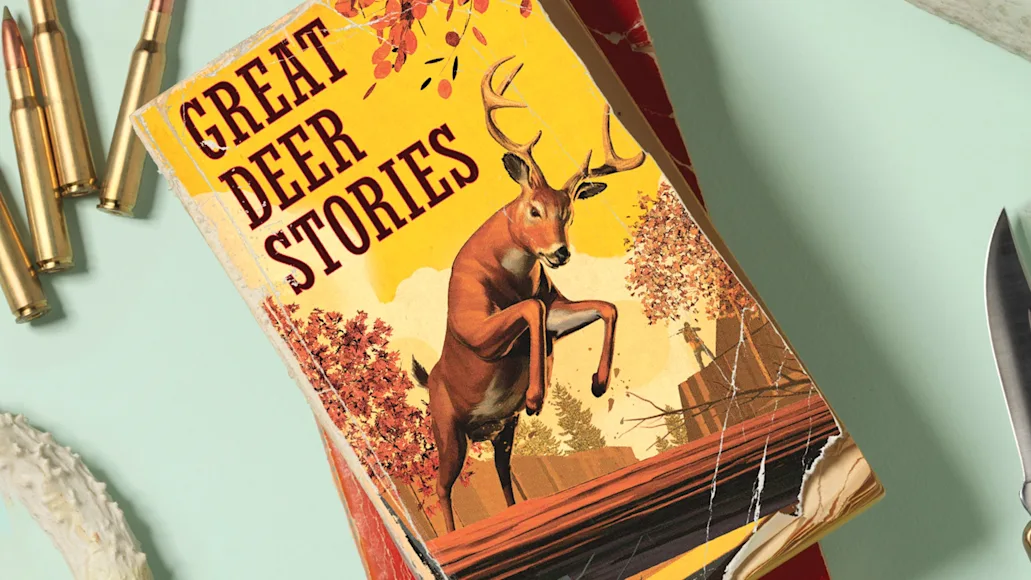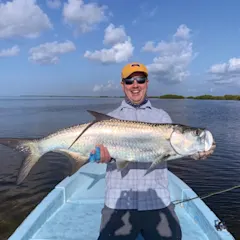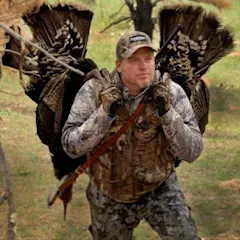NOT EVERY TRIP into the deer woods ends with a deer, but hunters always come home with a new story. Because stories are everywhere in the wild. Some are short, others are epic, but they’re all special because they remind us of everything we love about deer and deer hunting.
With that in mind, we wanted to devote an entire collection of great stories to deer. The writers were given titles named after various phases and moments of a deer hunt and asked to share their best story. Their accounts are grouped into chapters that represent the most elemental stages of a deer hunt—Anticipation, Pursuit, and Harvest. Individually, the stories are all enjoyable in their own way. But when you read them together, the narrative builds from tale to tale. Collectively, they tell one great deer story.
Chapter 1: Anticipation
The Drive to Camp
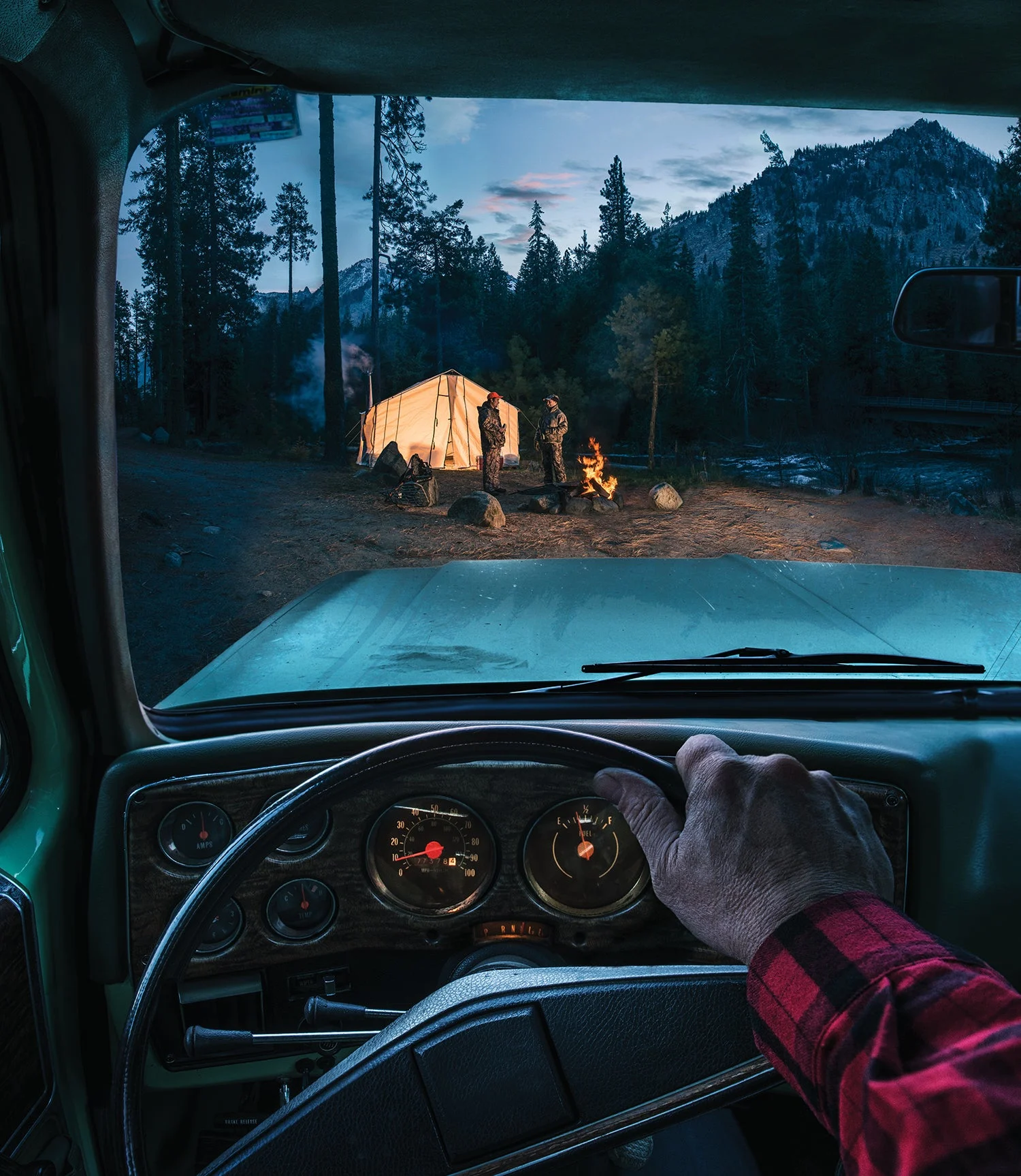
Nick Hall
At the top of Mountain Pass, the glare in the rearview was like the afterglow of a device gone off in a long-overdue airburst above the coastal city. Then the interstate descended the Nevada side of the Clarks, leaving the Joshua trees behind; and the glare sank away, the highway flattening out and running straight as a ballasted railroad across the dry lake bed, the desert air growing slaty with the dusk progressing toward night. At last light, in the next lane, was another pickup with a camper top or a load in the back lashed under a tarp. A Jeep CJ crammed with gear, jerry cans on the rear and a rifle rack mounted inside, came up and slung past. As the headlights came on, the traffic buttons glowing like cats’ eyes, the lights of Las Vegas mounted ahead.
It was like the Dust Bowl exodus in reverse, two generations later. The real Californians, the ones with roots going back before the war and the displaced sharecroppers’ westward migrations, had their places to hunt in California. For the rest, in their tens of thousands, the way to the deer was a matter of returning the way they came, at least as far as Utah, Colorado, and Wyoming. And everyone went through Las Vegas.
I was one of those Californians with multigenerational roots; but my people were not hunting people, and there was no ranch or mountain cabin. I heard the Colorado hunting stories, though, told by my father’s friends, and I wanted to travel with them to hunt.
This, then, was my first journey on the mule deer highway. Although I didn’t know it, I would follow it almost without interruption for 15 years.
By dawn we would be driving the trucks across the Utah-Colorado line. In Grand Junction, we’d take rooms, buy our licenses and supplies, sleep overnight, and the next morning be working our way upward through the axle-deep mud left in the shaded draws by early snows to churn out onto Skinner Ridge. Among the Gambel oaks and piñons and mountain mahogany was the campsite the older men had used throughout the ’60s, and that was where we pitched the surplus pyramid tent for cooking and the wall tent for sleeping.
Into the wall tent we would bring the folding beds and sleeping bags. The tables, worn and whittled on, would be set up in the pyramid tent, and then the pots and pans, knives and forks, cups and plates, in the old U.S. mailbag, went in, along with the Coleman stove. Boxes of groceries followed, and it would already be time to start sorting through them for dinner: thick steaks, fried potatoes, salad with the inevitability of Italian dressing.
I heard the hunting stories told by my father’s friends, and I wanted to travel with them. This, then, was my first journey on the mule deer highway.
The lanterns would be lit and we would eat. After the meal there would be the washing, while for some there would be gin playing, and for others, vodka drinking, a Bloody Mary with tomato juice, or a red beer. On the table would be the radio with the AM and FM and shortwave bands. We would try to tune in the news or a game, then listen until the station faded away, before extinguishing the lanterns and going to sleep.
The stars would be out in the morning in abundant acuity; and the sun, coming up over where the ridge bluffed out, would find me still-hunting into the wind along a trail. On this trail, or another in a different side canyon running off the ridge, the memory vague now, I would jump and kill my first mule deer buck, no more than a forkhorn, then hurry to find one of the older men to show me how to field dress a deer, and to help me drag it back up the trail to where we could lift it into a truck.
In the afternoon, with the tagged and dressed buck hanging in a tree by its rack and October light cascading through the yellow leaves onto the stained canvas, the music or the news report on the big radio would be interrupted by the Buckskin Network, relaying emergency messages to the hunters scattered across the ridges and mountains. Phone home, the messages said, and you felt for the ones whose names were read, not just for what might be waiting on the other end of the line, but for having to come off the hunt, to leave the real buckskin network of hunters.
All that lay ahead, though, as did the older men growing into old ones, and their trips on the highway concluding. Then I would have to find other places to hunt my deer, and others to hunt them with. Now it was about driving through Vegas, registering under the incandescence of downtown at the Golden Nugget—where they held a contest for the biggest buck—before eating the prime-rib special and topping off the tanks.
The city lights would be behind us as we drove away from Las Vegas. And the headlights of the trucks would assemble with us in the sable night as we were bound for what we desired, what we could not seem to locate in California. —Thomas McIntyre
The Fight
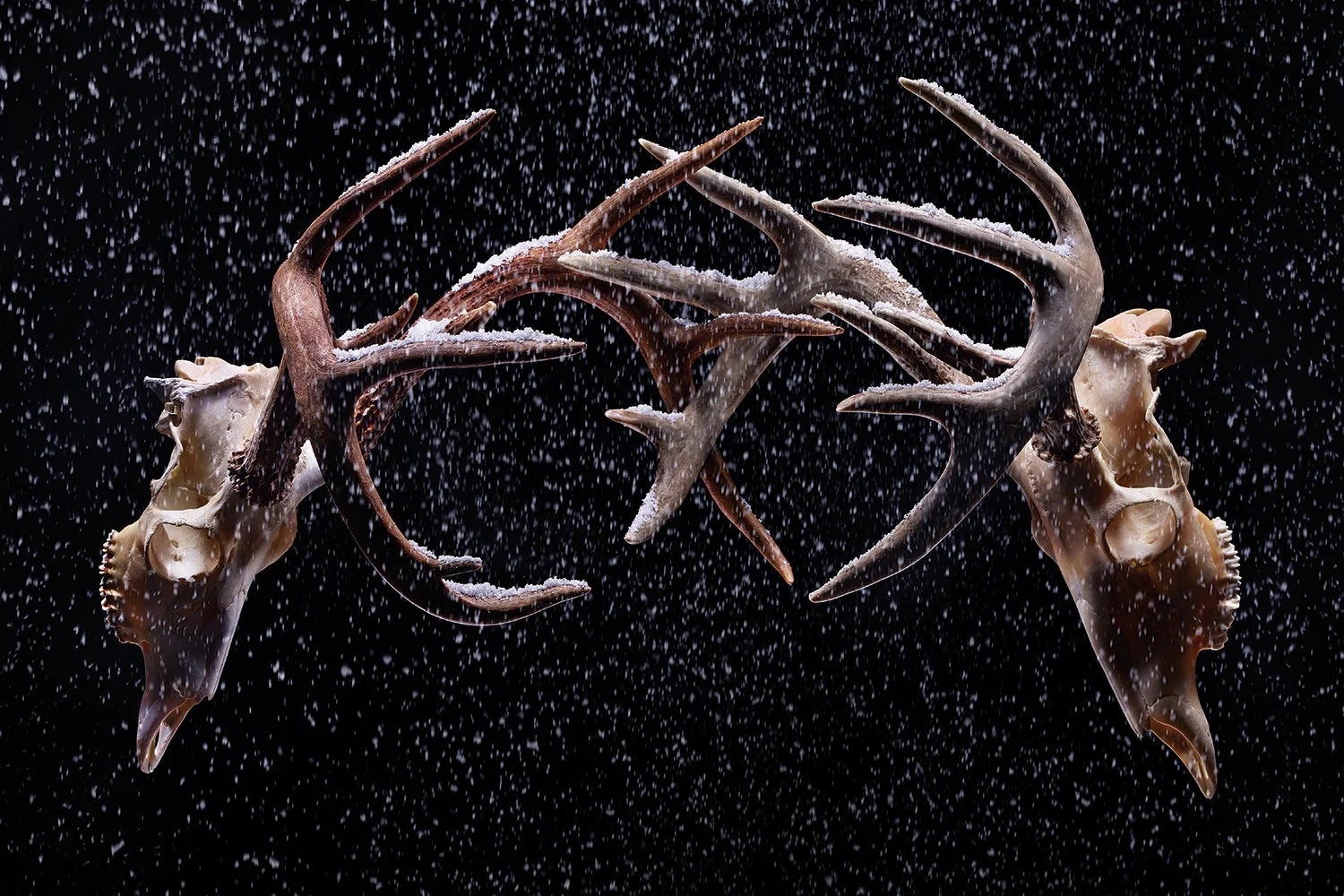
Adam Voorhes; Robin Finlay (prop styling)
It was the first week of November—the heart of the seeking-and-chasing phase, magic time. So I stood up, bow in hand, as soon as I heard the mincing steps of a deer. The sleek head of a doe emerged, her forehead and eyelashes dusted by snowflakes. She shook her coat clean and looked down her backtrail as I heard heavier, shuffling steps—and spotted the chocolate antlers right under my stand.
The doe was still staring behind me, and when I followed her gaze, I saw three more bucks walking into bow range—a forkhorn, a small 6-point, and a tall-tined 10 with a white rack and a sorrel face. The chocolate-horned buck instantly laid his ears back, bristled, and stiff-legged it toward the 10.
Most fights—man, dog, or deer—start with some preliminary bluster. Not this one. The chocolate-horn lowered his head and crashed into the antlers of his rival so hard it sounded like a 2×4 cracked against a telephone pole. The impact drove the white-racked buck back, his hooves scrabbling over the snow-dusted oak leaves. With a groan, he dug his hind feet in and pushed back.
Once, twice, three times the buck plunged his tines into his opponent’s ribs.
For nearly 10 minutes, just 20 yards from me, the bucks mashed antlers, pushing with a force that would roll a small car. Twice they stood in a seeming stalemate, their flanks exposed and heaving—and it occurred to me that I could slip an arrow into one of them. But each time, the bodies quickly shifted, and the opportunity vanished. Almost relieved, I let the show unfold.
Physics won the day. Although the white-racked 10 seemed stronger, each time he’d shove, the chocolate-horn deer would slide his back legs slightly more uphill until he had the advantage. Finally he drove hard downhill, twisted his head, and flipped the 10-pointer on its side. Once, twice, three times chocolate-horns plunged his tines into the exposed ribs. Miraculously, the white-rack popped to his feet, then whirled to flee. Chocolate stabbed him once more in the hams and chased him out of sight.
The woods fell silent. The doe, the reason for the fight, wriggled nervously into some brush. The two smaller bucks looked briefly at each other, and then followed her up the long, tangled hillside. —Scott Bestul
The Hog Barn
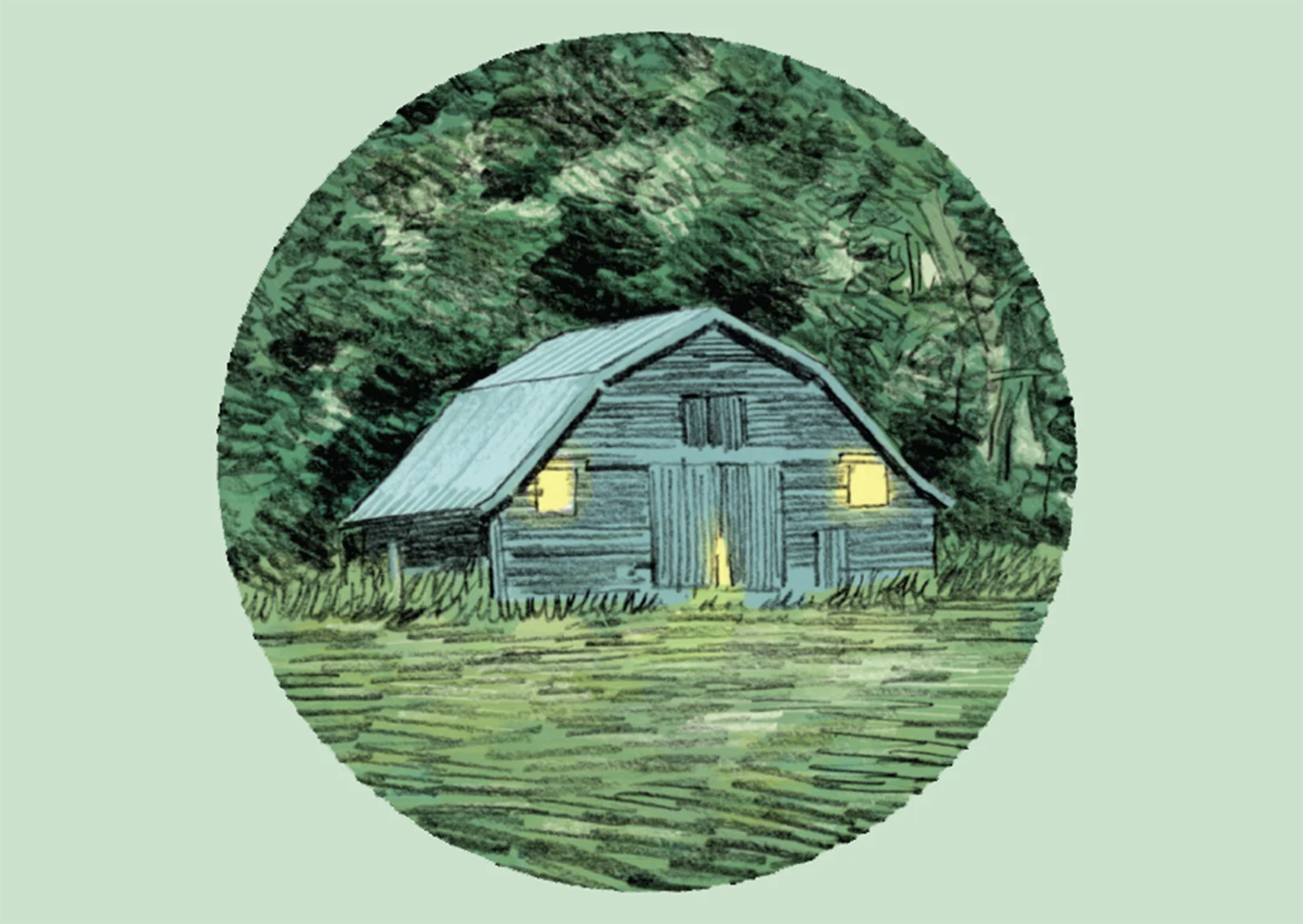
Graham Samuels
I turn off the hardtop and follow the headlights as they sweep across the soybeans, and there it is, low and ghostly white against the big timber. The hog barn. It’s dark as sin this morning. No sign of a truck. Scott must still be on the way.
The big doors screech in the old tracks, so loud I flinch. I’ve opened these doors a million times, but I still half expect some crazy owl or rabid opossum to come flying out. My headlamp beam lights up a hodgepodge of gear inside, then flashes on the laminated pin-in map. Peering close I start the obsessing—plotting the approach to the stand, drawing imaginary whorls of wind through the woods, recalculating the deer’s likely movements from the oak ridge to the swamp thicket.
An outside light jabs the dark interior, little stilettos knifing through holes in the walls. Must be Scott. He knows where I am. We’re meeting at the hog barn.
It’s been this way for years, every time we hunt. For us, every day in the woods begins and ends at the hog barn. It’s where we plan the hunt about to take place and dissect the hunt that’s over. It’s where we change clothes, skin the deer, chew the fat, commiserate, celebrate. Every hunt begins and ends with a shibboleth, anchored in this most prosaic of structures.
Meet you at the hog barn.
Leave the chain saw in the hog barn.
Are the keys in the hog barn?
See you back at the hog barn. Good hunting.
This morning is no different. Scott and I talk in hushed voices, pull on knee boots, grab backpacks, mute cellphones, agree on how long to stay in our treestands. Then it’s into the woods. No reason to run a light. We both know the way. Scott disappears into the dark like vapor. We can plot and plan all we like, but whatever happens over the next few hours is the great mystery of deer hunting. Except for this: We’ll hear about it at the hog barn. —T. Edward Nickens
The Emergence
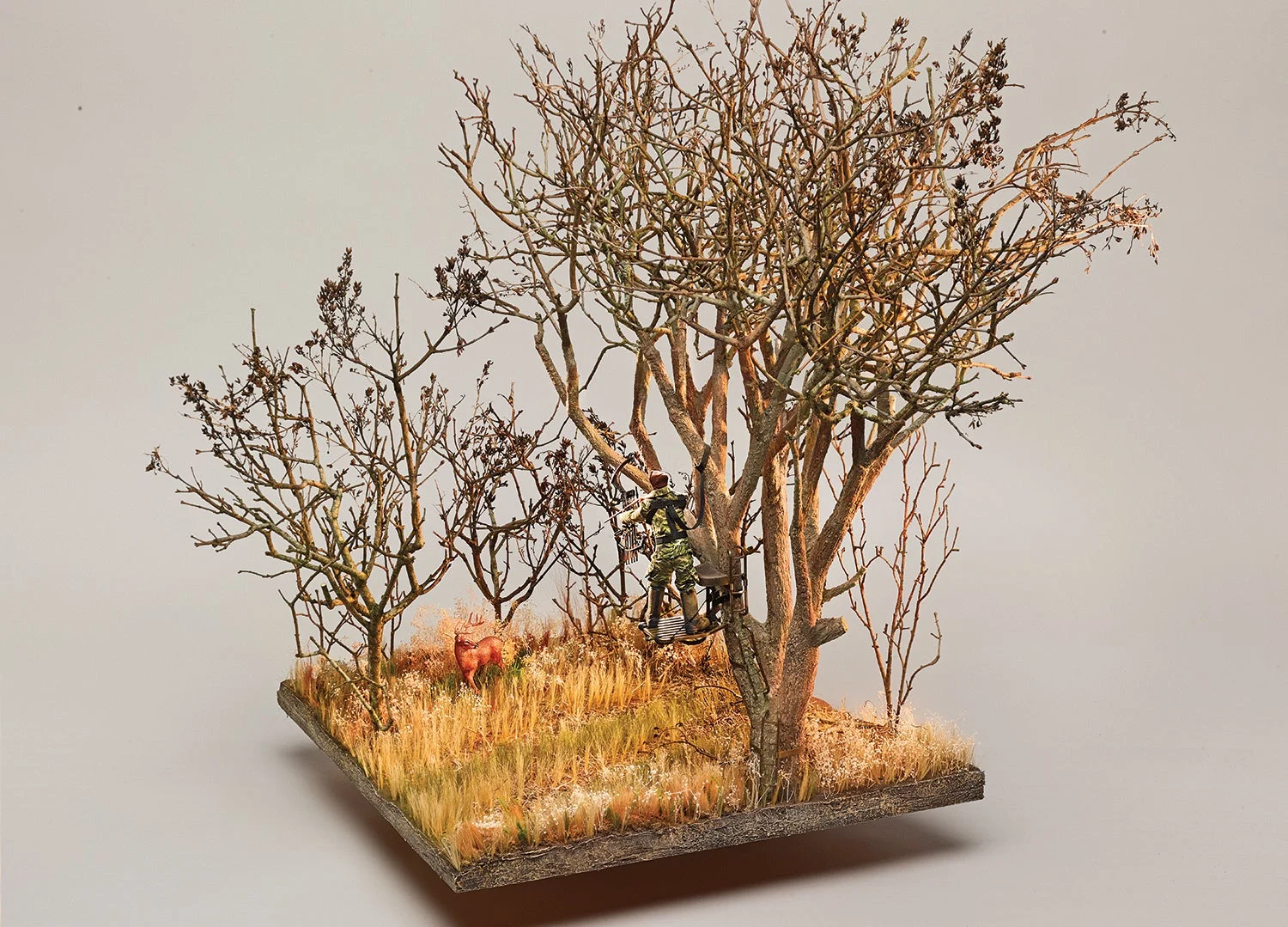
Adam Levey; Geahk Bburchill (diorama design)
I’d seen only his dark form shrink away down the long length of a ryefield at dusk and then bank west onto a grassy lane that divided a knob, with hardwoods on one side and a mess of saplings and ragweed on the other.
I knew exactly where to kill him.
The next day at noon I hung a stand on the wooded edge in the fork of a silver maple and waited. For hours, there was nothing. There was the deserted, grassy lane; and the byway of deer tracks running its length; and the faint trails cutting in perpendicularly along the knob, through the ragweed, between the saplings, every one raked bare and shredded.
It was early November, not quite 5 p.m. The northwest wind, which had been flipping red leaves silver-side up, settled. The fox squirrels stopped thumping in the litter. The jays quit their shrill piping. And there he was.
He didn’t weave through the saplings or step onto the grassy lane. He was just there. Twelve soaring, clean points—180 inches, give or take. Fourteen yards away, facing me, front legs standing on the lane, rear ones in the weeds, whose edge I’d hit with a rangefinder.
Right then I felt as though I hadn’t climbed into my stand but had levitated there and was still floating. More than that, I felt certain I was going to kill this giant. When I reached for my bow, the stand made the faintest creak. The buck lifted his head and stared beyond me. I froze, thinking that like many deer only vaguely alerted he’d soon flick his tail and keep coming. I’d let him walk by and arrow him quartering away.
But he just stood there and stared, for an honest five minutes…10 minutes…then he spun, as if on a heel, and slunk back into the ragweed and saplings. Fifty yards away and out of range, he circled over to the sunlit side of the knob, stepped broadside into a small clearing, and stood there for the longest time—muscled and giant and perfect—as if to show me what a whitetail buck could be, and exactly what I couldn’t have. —Dave Hurteau
The Walk In

Peter Rad
Nothing beats the feeling—your heart full of hope and anticipation, your senses already working overtime—of sneaking into the whitetail woods in the dark-dark. Electricity and flashlights have made us such strangers to darkness that it takes an act of will not to push that button and destroy the night. But the less light you use, the less you disturb the woods. The best is when there’s just enough light from the moon and stars to follow a path. There are other advantages to operating in the dark. One is that reduced vision makes your ears work that much harder. The biggest, however, is that darkness forces you to do something that animals do constantly and that humans almost never do in daily life, which is to move as though you have all the time in the world.
As the Lone Biped of the Forest, your normal cadence—even if you’re walking in slow motion and pausing every few steps—is the woods’ equivalent of a fire truck’s siren. I always take a walking stick, the better to sound like another deer browsing its way back to bed. Whenever I’ve been pinned down by does or listened to unalerted deer under my stand, they always seem to move in an odd number of steps. Now I do the same. I’ll take five or seven steps (including stick-steps), pause a couple of beats, move one or three more, and do a longer pause. Sometimes, as I do this, it occurs to me that I may be hunting really effectively or, equally likely, have just become eligible for free mental-health counseling.
As the lone biped of the forest, your normal cadence—even in slow motion—is the woods’ equivalent of a fire truck’s siren.
I’ve bumped countless deer on my way in and know too well the heart-sink of hearing hooves crashing madly away through dry leaves. But there have also been times when I snorted back, stamped my stick a few times, and was taken for another deer. It’s not hard, and because so few humans ever try it, it’s not necessary that your snort be pitch-perfect to fool most deer. I roll my tongue, purse my upper lip out, and exhale sharply. Mine is lacking in the musical note of a real deer’s snort, but I’m pretty good on the air part.
When I finally arrive at my tree, it may be bright enough to see, but my first priority is still making the least possible amount of noise. I figure the deer that can see me have already done so. It’s the nearby ones that may be shielded from view that I’m focused on. It’s possible—if you’re careful and your tree’s circumference is less than your wingspan—to attach both platforms of a climber and secure a tote rope to your bow without moving your feet. I attach my climber at the maximum height I can pull myself up to from the ground, inchworm slowly to my desired height, screw in the bow holder so the bow’s grip is just above waist-high, and try to become one with the bark and branches. —Bill Heavey
Chapter 2: Pursuit
The Campaign
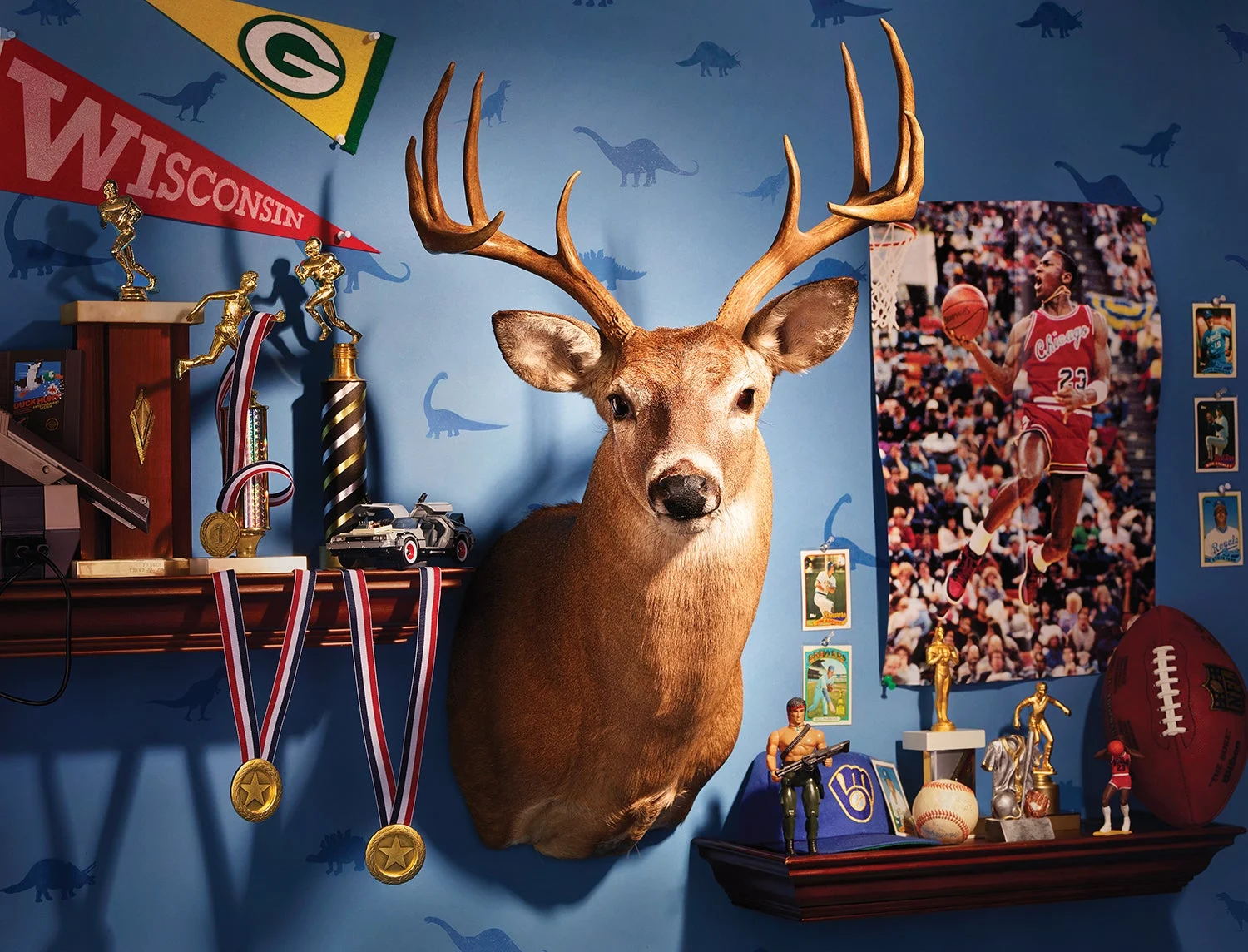
Adam Voorhes; Robin Finlay (set design)
I had skipped school to deer hunt before, but always from the other side of the desk. This time, as a third-year English teacher, I told my principal I had a dentist appointment and would be late for a November workshop day that only the students had off. “Fine,” said my boss as I stared at my shoes, “but you’d better be in that classroom by 11 sharp.”
The real excuse was Picket Fence, a whitetail I’d first seen on a calm late-October morning when, after hearing the deep uuuuurpp! of a buck dogging a doe, I looked out across a broad valley and spotted his white, perfectly symmetrical, 12-point rack from 300 yards away. I grabbed my binocular and watched him for 10 minutes as he pushed the doe along the far hillside. He was the biggest buck I’d ever seen.
Later, when I walked over to investigate the chase scene, I found the hillside trashed with rubs and reeking of scrapes. This was part of his core area. He’d be back. I hung a stand in a double-trunked white oak and left. When my head hit the pillow that night, all I could think about was Picket Fence.
At dawn, in my new stand, I thought I heard his distinctive, guttural grunt. I grabbed my bow and stood as a young doe bombed past. Hearing another, softer grunt, I turned to my right and spotted a second doe weaving through the brush above me—with a buck trailing close behind. Squinting through the cover, I made out only 8 small points. The tension left my shoulders. Then, for no reason, I turned to my left and there was Picket Fence, his tall, white rack sliding through the brush 60 yards off. I grunted, but he seemed bent on reaching the ridgetop—a favorite bedding area for big bucks.
My job kept me from hunting during the next week, but I was back in the same stand Saturday morning, marveling at the blowup of buck sign since my last sit, confirming that I was still in Picket’s wheelhouse. I didn’t see him the first morning, but on Sunday, around 11 a.m., I heard leaves rustling 60 yards to my left and turned to see a pair of agitated does wriggling through a patch of cedars and into the open woods. Picket was shadowing them, taking a step, pausing to read the does’ body language, licking his nose. Suddenly, he snapped his head up, spotting a small buck chasing another doe up the hill, and bolted off in pursuit.
The does flicked their tails in unison and stepped confidently down a trail 30 yards out of bow range, giving me the clue I needed. While I’d been sitting in the thick stuff near the hottest sign, does were now cycling and Picket was walking where they did. At the end of that morning’s hunt, I moved my stand to a clump of basswoods, out of the thicket and overlooking three pounded trails.
The following Friday was my “dentist” hunt. It, plus the weekend, was my last, best chance before gun season began. I was in the basswoods in full dark, plotting out my hunt to the minute while waiting for the sun. I needed 15 minutes to reach my car, 10 to change clothes, and 35 to race to school—an hour total. By 9 a.m. I hadn’t seen a deer. At 9:30, I was still working on a skunk. At 10, I decided that it was just one of those mornings.
I crawled down, gathered my gear, and took three steps toward my vehicle. And there, standing like a lawn ornament at 40 yards, was a huge doe. As we locked eyes, behind and above her I could see a set of unmistakable antlers. One more minute and Picket would have followed her right under my stand. The doe stomped her foot once, backpedaled uneasily, and whirled. Picket never saw me, but he followed the doe. And I got to my classroom at 11:15.
As I raised the bow, beginning to draw, a doe exploded from her bed next to Picket. His great, gorgeous head swiveled before he careered off the bench in a flurry of mud and leaves.
That night a front moved in, full of cold rain and November wind. I sat in the basswoods again the next morning, but I knew Picket wouldn’t show. Deer seem to shun those hardwoods in bad weather. I sat a field edge in the evening, in a maybe-I’ll-get-lucky stand that produced a lonely nubbin buck. Tomorrow would be my last shot, and the weather forecast was little improved.
The morning barely dawned, the sky only shifting from black to gray. The rain had slowed to a drizzle, but as I settled into the basswoods again, I knew I was just marking time. Then I remembered my second encounter with Picket, the morning he ignored my grunt call and beelined to the ridgetop bedding area. I gathered my gear and scrambled down the tree.
The hike was steep and tangled but wet; the ground and even the brambles that tore at my clothes made no sound. Topping the ridge, I dumped my pack and shed every piece of nonessential clothing, as well as my boots. Down to a ball cap, shirt, camo pants, and wool socks, I grabbed my recurve bow and started sneaking.
Ahead, at 60 yards, was a brushy bench just off the ridgeline, a perfect place for a buck to hide. With the wind on one cheek, I slipped forward 30 yards along an old logging road, then dropped to my knees and glassed the cover ahead. Then I crawled another 5 yards and glassed again. In the middle of my next move, I spotted a single white beam against the thick dogwood. Picket was looking downhill and away. I nocked an arrow and edged to where I could see a clear lane to the buck’s ribs, 20 steps away. As I raised the bow, beginning to draw, a doe exploded from her bed next to Picket. His great, gorgeous head swiveled before he careered off the bench in a flurry of mud and leaves.
Five days later, within the first couple of hours of the gun-season opener, Picket came trotting, pretty as you please, right under a stand, chasing his last doe. “My son Scooter killed a monster,” the owner of the neighboring farm told me that weekend. Then he described the rack: “Tall, heavy, bone white, unblemished…it netted 173.” If I felt a twinge of envy, I don’t recall it now. A 15-year-old kid I knew shot a Booner; I was happy for him. And he was thrilled. But when I talked to Scooter, I sensed that, at the time at least, he didn’t fully appreciate how special a buck Picket Fence was.
But I did. —Scott Bestul
The Blood Trail
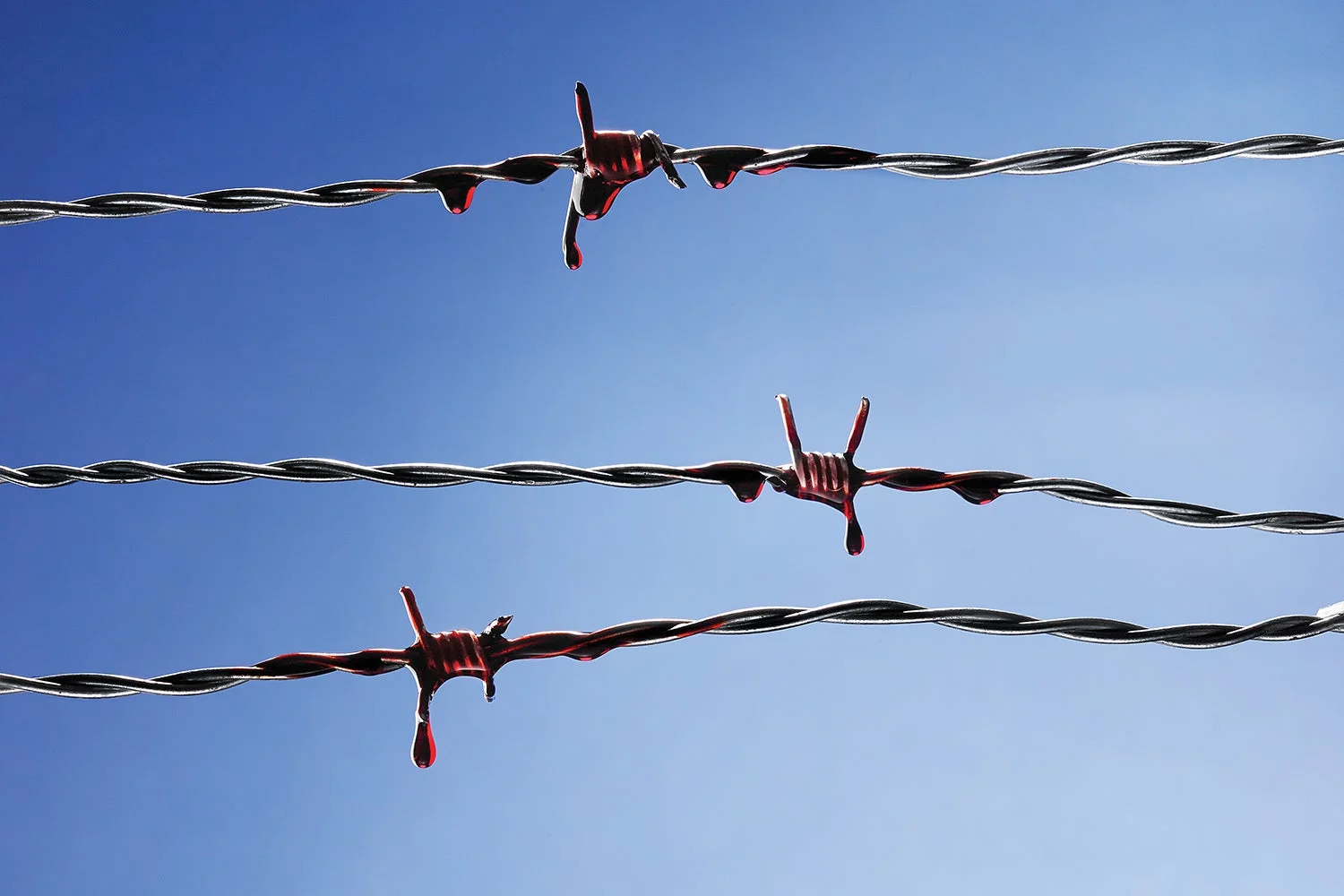
Yasu + Junko
The rifle seemed solid in the shooting sticks, crosshairs steady. The shot felt good, one where you almost expect to see the buck flop. Instead, he bolted, clearing a four-strand fence before disappearing into a windbreak that lined the CRP field.
Andre, my guide, saw a hitch in his gait, and we agreed: The buck was hit, but not well.
Soaking into the rusty barbwire was only a speck of blood. Across the fence, where he landed, was a bit more, lightly splattered in the dead grass. Every hunter who’s ever shot an animal knows there’s good blood and bad blood. This was bad blood—the spotty, bright-red droplets of a flesh wound, each one nagging that you alone are responsible.
During the next few hours, between specks, occasional vivid splashes on the monochrome landscape would make me think, Maybe he’s lying just up ahead. At one point the buck had stood in an island of big bluestem, no doubt watching us work out the details of his trail before limping away. The blood that had pooled in his tracks gave me some hope.
But then the trail lined out, crossing a huge pasture—and all but disappearing. I hate to admit it, but without so much as a glimpse of the buck, we talked about giving up then, rationalizing that maybe the wound wasn’t as bad as we thought. Instead we broke for lunch.
It was a full eight hours after the shot when we picked up the trail again. The pin-size drops led to an abandoned corral packed shoulder-high with tumbleweeds. In the thick cover I had to stoop to work out the blood trail, which had begun to wander back on itself, like that of an animal getting ready to bed down.
“There!” Andre shouted, as I heard a rustling in front of me. Fifty yards ahead, antler tips plowed through the brush. In the tunnel vision of the scope all I could see of the buck was a spot of hair where his head and neck met. At the crack of the rifle, the buck crashed.
And just like that it was over—the deer’s suffering, the eight-hour tracking job, my own personal torture. After missing a shot that I should have made, I followed up with one I probably couldn’t make again. It didn’t make everything right. I didn’t feel good. But I’ve never felt so relieved. —David Draper
The Tradition
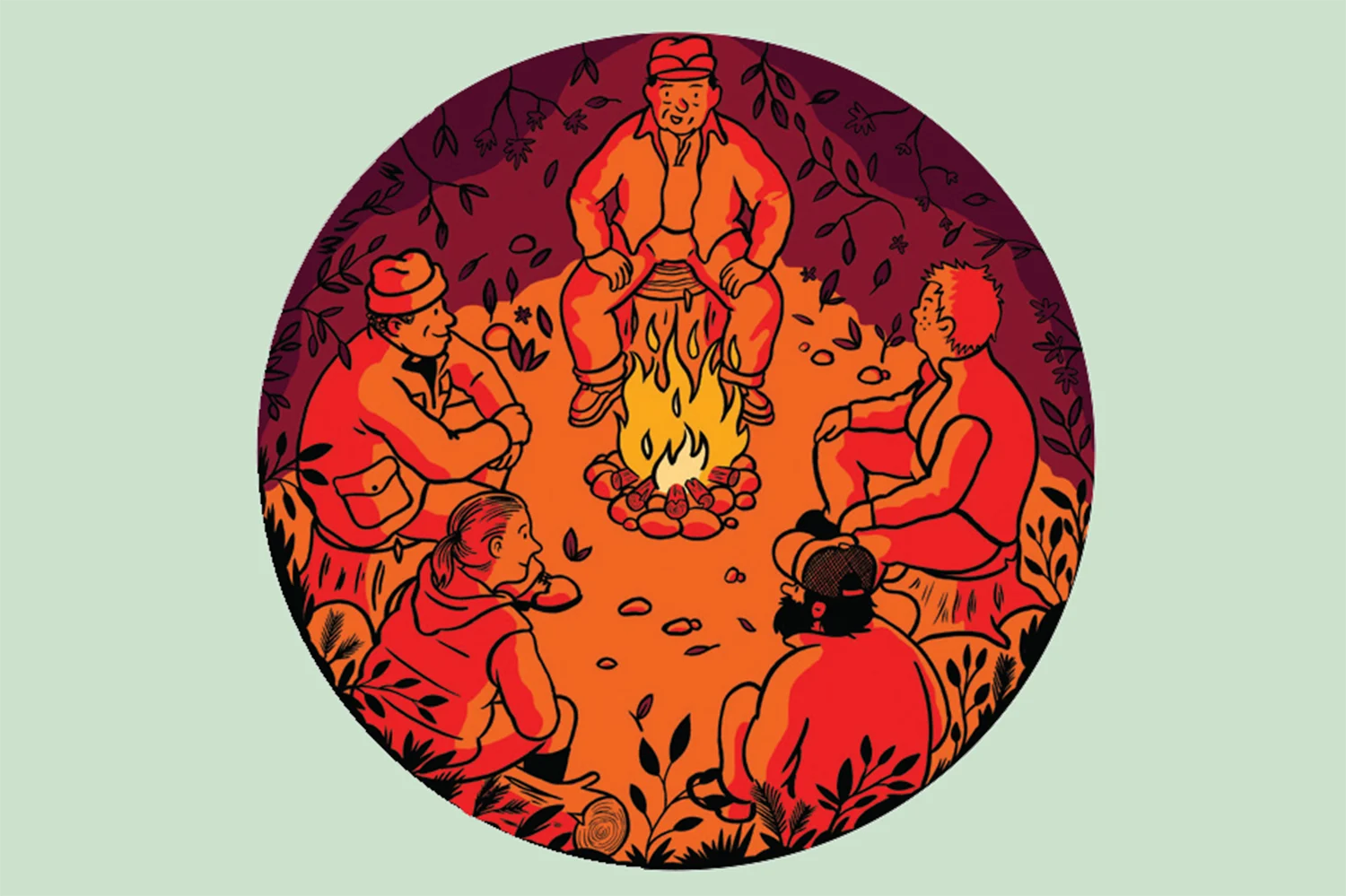
Peter Gamlen
It was an unusual deer camp. There were 12 of us—some friends, some strangers, all business associates—hunting blacktail deer on Alaska’s Kodiak Island and living aboard two 50-foot boats. At night we tied up and packed into one cabin for a communal supper. After everyone had a drink or two and had eaten enough grub to take the edge off, our host and leader, Doug Jeanneret of the U.S. Sportsmen’s Alliance, would announce: “All right, it’s time for High and Low.”
The rules are straightforward: Everybody picks his high and low moments of the day and shares them with the group. But the results are not so simple. Identifying your most meaningful experiences forces you to think introspectively about your day afield. You learn surprising things about yourself and about your fellow hunters.
I heard my companions talk about the highs of reaching the top of a mountain that rises straight out of the sea. There was the sight of a fox, bright orange in the sun, trotting across the tundra and of a brown bear scratching its back against an alder bush. We shared lows of blown stalks, brutal hikes, and scary beach landings in heavy surf. There was the huge boar brown bear that galloped in front of two guys, all three of the predators after the same deer. It could’ve been a high or a low. For one hunter, the high of the solitude and peace he found in the Alaska wilderness was followed by the low of missing his young son.
The highs and lows that really resonated caused people to raise their drinks in tribute.
After Kodiak, I brought this tradition to all of my hunting camps (and, on special occasions, to the family dinner table, where my young son loves it). It’s always a hit for one simple reason: Hunters crave stories. These days it’s too easy, even in deer camp, for people to retreat to the TV, computer, smartphone. High and Low keeps the ancient campfire tradition of storytelling burning, even on a boat in the Gulf of Alaska. —Anthony Licata
The Gun

Fredrik Broden
It is a long way from a movie theater in North Carolina to last light on the last day of the deer season on a Montana mountain, but that’s where this story starts, with the curtain coming down and the credits coming up, and a date by my side whose name I’ve long forgotten.
“He was looking for a Hawken gun, .50 caliber or better,” the narrator said in Jeremiah Johnson. “He settled for a .30, but damn, it was a genuine Hawken, and you couldn’t go no better.”
The movie made such an impression that in two years’ time I would set my compass as my hero had—due west, turn left at the Rocky Mountains—and try to do Johnson one better by building my own rifle, and a .58 at that. I drove a chisel through my palm while inletting the lock, and the first time I fired the rifle, the recoil split the stock and bloodied my nose. But my pilgrimage would not be derailed by matters of such inconsequence. I might have been born a century too late to follow Johnson’s example, but the West was carved from rock and the rock was still there, and the last of the great country falling from the peaks, and I was determined to pay homage to those who pioneered the trail by hunting their way, the hard way. No reach-out-and-touch-them magnum, no scope cranked to 10X to shoot across the canyon. That wasn’t hunting. Hunting was tracking game with your nose to the wind—one chance at a range where you saw nostrils quiver as you thumbed the hammer, and every bite of venison a sacrament to a time gone by.
I brought down my first deer on a slope of the Continental Divide while camping in a converted bus with my parents, who were so worried about their son that they followed him just to make sure he had a place to come out of the cold. My father was a hunter, but the blood didn’t pound for him the way it did for me; he would think about the difficulty of packing an animal out before taking the shot. I thought of it after the smoke cleared enough to see the deer lying on the snow, the road a good 7 miles down in the valley. Right about then a friend with a stout back would have come in handy, but like Johnson I made my own way in the mountains, and as my father had had open heart surgery, he could offer little more than moral support as I packed out the boned meat.
Never again would I turn my eyes East. I married, moved to Montana, and began to raise a family on the animals that fell to the Hawken, staying on the high horse of principle born of celluloid film. But unlike Idaho, where I had shot that first deer, my adopted state didn’t have a muzzleloader season, and I found myself hunting country where everyone else packed centerfire rifles. Those men didn’t have to worry about how far down to pull the front blade into the V-notch. It didn’t take them 45 seconds to reload, nor did anyone with a modern rifle have to discharge it every night, so that the next day began with a charge of fresh powder. Most important, smokeless poles spoke when you pulled the trigger. The Hawken sometimes didn’t, especially on damp days, but also because the hammer did not fall quite squarely onto the percussion cap—an error of being off a fraction of an inch when I inletted the lock.
One year I blew my chance to fill the freezer when the hammer clicked onto a cap, the whitetail gone like smoke, then later I lost one of the biggest mule deer I’ve ever seen when a shot hangfired—ka, ka boom—the buck standing broadside and staring as numbed fingers fumbled with the ramrod.
The last day of that season the sun never coaxed the mercury out of the bowl of my zipper thermometer. It was so cold I had stopped to build a fire when a string of elk materialized out of the timber. The animals were winter meat at a time in my life when it was sorely needed, but when I reached for the rifle I found that snow had melted between the hammer and the side plate, then refrozen to cement the mechanism solid. I thawed the lock over the fire while the elk made up their minds, and watched with a sinking heart as one by one they disappeared into the pines.
By the time I got off the mountain, the season had come down to last light. A few days earlier and a mile down the road, I had seen a mule deer buck with a string of does, and there was just enough time to climb that ridge if I hurried. At the pullout, I opened the trunk of my father’s Chevy Nova, which I borrowed from time to time after he moved to Montana, to get my rifle and noticed the horse blanket Dad kept there. Under it was a .30/30 Winchester with a saddle ring and an elastic sleeve of cartridges. A moment’s hesitation as a decade of idealism came to an end…then I grabbed a rifle with each hand and schlepped up the ridge. And there was my buck. This time the muzzleloader went boom, but my heart was hammering and the patched ball missed. I dropped the Hawken, jacked a shell into the Winchester, and ran up the hill. He hadn’t gone far because his does hadn’t gone far, and the story that started in North Carolina came full circle when he fell.
I still believe that the measure of a hunter is not how far he shoots but how close he gets to make sure of his shot, but I have come to understand that a rifle is only a tool, and that you don’t need a cloud of smoke to conjure the spirit of your ancestors. The .350 magnum I carry now may not have the same aura of romance, but it thunders when you ask it. As for the Hawken, it hasn’t spoken since last light on that mountain. I stuff money down the bore where it rests over the mantel, underneath the skull and antler mount of the mule deer buck. To dinner guests who notice it I tell this story, and those who have eyes to appreciate a sunset understand, for they have once dreamed too, while those who look to the horizon and see only weather just smile and shake their heads. —Keith McCafferty
The Miss
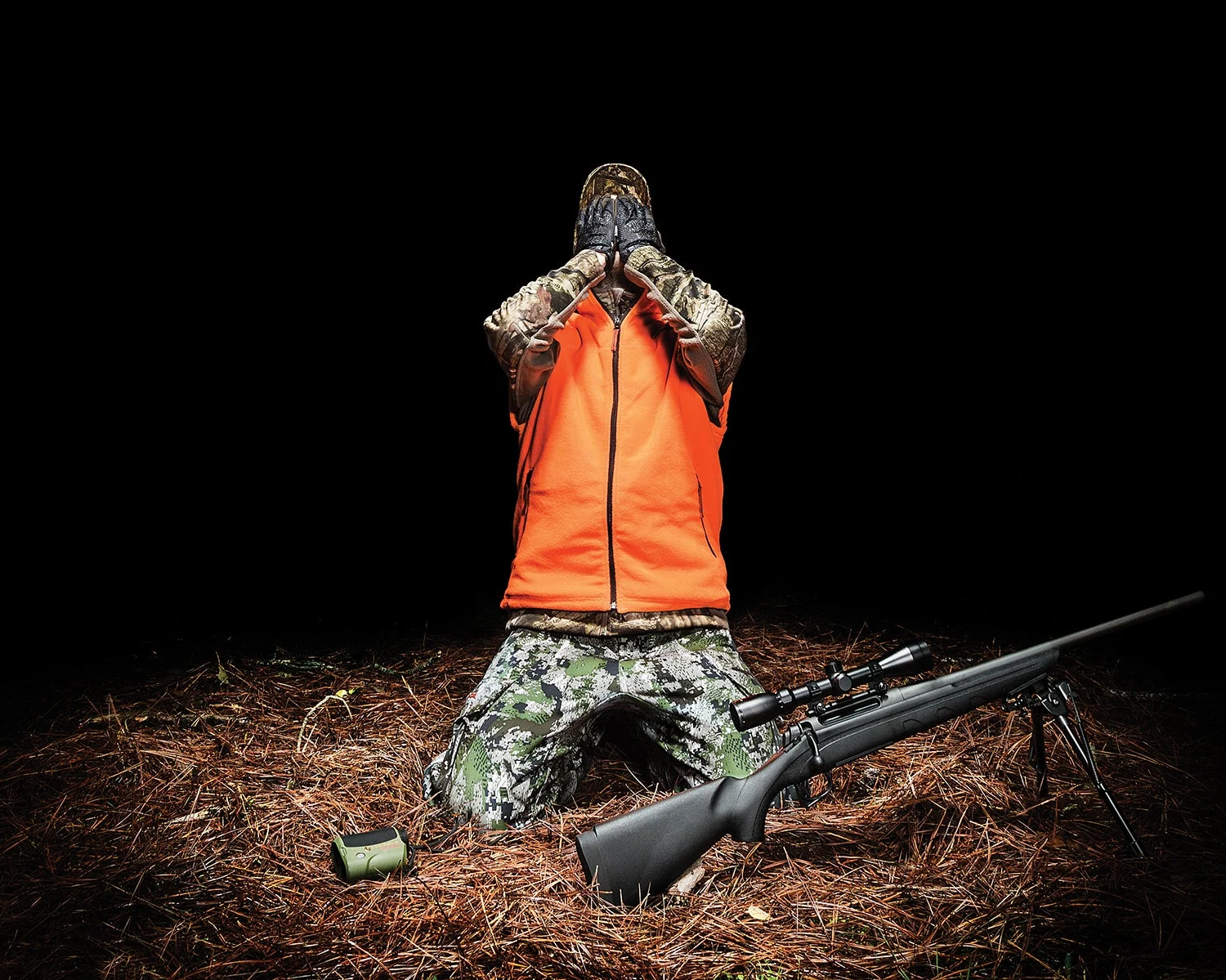
Jeff Wilson
I missed the buck on a mountain in Southeast Alaska that was only 6 miles from my cabin. But with the impassable cliffs and the overwhelming thickness of the rain forest, it might as well have been 600 miles away. The only way up there was to charter a floatplane to a lake just below timberline, which I’d done. From there I backpacked upward into the subalpine zone in search of blacktail deer for the next five days.
I discovered the buck on the third day. Or rather, I should say that the buck discovered me. I was working along the top of a cliff edge that dropped down toward a lake. It was rough ground, with open hilltops that were surrounded by nasty tangles of head-high brush. I was headed toward a prominent knob from which I could hopefully glass a distant animal, but suddenly here was this bruiser of a blacktail—easily the biggest I’d ever seen, and I’d seen more than a few—running away at 75 yards.
This wasn’t how things were supposed to go. When I’d hunted similar terrain before, I never had a problem finding bucks without spooking them. They’d usually be 500 or 600 yards away, feeding on a neighboring hilltop and completely at ease. But by the time I’d chop that distance in half in order to make a shot, usually by crossing some brush-choked hellhole, the buck would be long gone.
The solution, I figured, was technology. I got a long-barreled rifle fueled by handloaded ammo, fitted with a bipod and a scope with exposed turrets. The key to this setup was a laser rangefinder. Once I glassed a buck, it wouldn’t matter how far away he was. I’d just zap him with the laser, dial the scope to the precise distance, and shoot him dead. Simple as that.
When I think about that big blacktail buck, which is something that I do pretty much every day, I realize that he first stopped at less than 200 yards. There isn’t a doubt in my mind about that distance. But I’d be damned if I wasn’t going to range that thing with my new laser first, so I fiddled away precious seconds by getting the rangefinder out of its case and wiping condensation off the lens. By then the buck was moving again. He stopped a second time at a laser-certified 250 yards, a perfectly doable shot if I’m prone and using my backpack for a rest. But I was now trying to employ my telescoping bipod, which was giving me fits. The buck moved again and then stopped for a third and final time at 360 yards. I dialed the scope to the appropriate distance and then blasted a chip from a rock face well over the buck’s back. After the deer turned and vanished in a final flash of antler, I realized that I’d accidentally dialed the scope for a 560-yard shot.
Had I killed that deer, I would have cleaned the skull and put it on my mantelpiece. I would have built a good story around it over time, something with a nice moral lesson about perseverance or the mastery of skills. Instead, the only moral to be drawn comes from the chipped rock that I left in the mountains that day: No matter how sophisticated our technologies become, they will never—despite the wishes of their proponents and the worries of their detractors—replace our brains. —Steven Rinella
The Shot
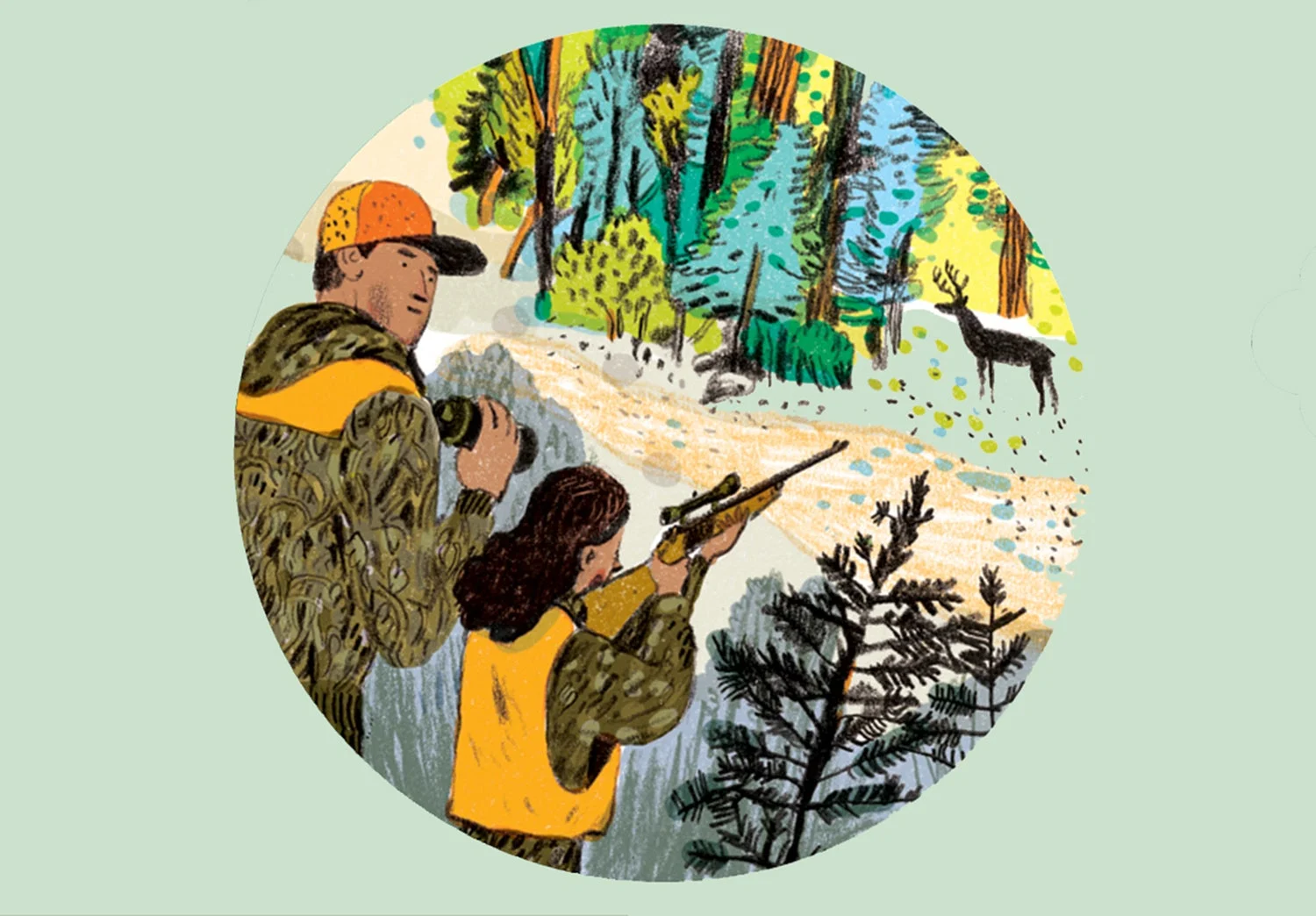
Peter Oumanski
Miraculously, the deer stopped in a narrow opening 100 yards away, just a few steps short of a cedar thicket.
“It’s a buck,” I whispered to my 13-year-old daughter, Grace, who had also closely followed the deer as it filtered up a brushy creekbottom, both of us desperately looking for antlers—she with her riflescope, me with binoculars.
“Can I shoot it?” she asked.
“Yes. But only if you’re sure you can make—”
Her cut-down muzzleloader roared and the deer vaulted up like a bucking bronco, all four hooves seeming to touch under its arched back. Then it disappeared with a bound into the cedars, leaving a small tuft of hair that drifted weightlessly with the breeze, dislodged from the lower part of the buck’s chest, just behind the front leg.
“Did I get it, Daddy?” Grace asked, the recoil having caused her to lose sight of the deer.
I hugged her. “I’ll be damned if you didn’t shoot it right in the heart!” I said. “I’ve never seen anything like that.”
Of course I’d seen deer shot in the heart. But before I had children, I’d always viewed it from behind the trigger. It’s an entirely different experience when you’re peering over your kid’s shoulder instead—how much clearer you see everything unfold, how much more acutely you feel the stress of the moment when you desperately want your child to succeed. I was almost as excited as Grace, who had hunted three years without seeing a buck, during which time her younger brothers had both scored at least once.
At the side of the sleek 5-pointer, I gave Grace another hug and told her how proud I was of her persistence and her determination to learn how to shoot well. After a few quick cuts, I pulled out the still-steaming heart and squinted at her through a jagged hole in its center.
“You’re my little Annie Oakley,” I said, and she beamed back at me. —Lawrence Pyne
The Stalk
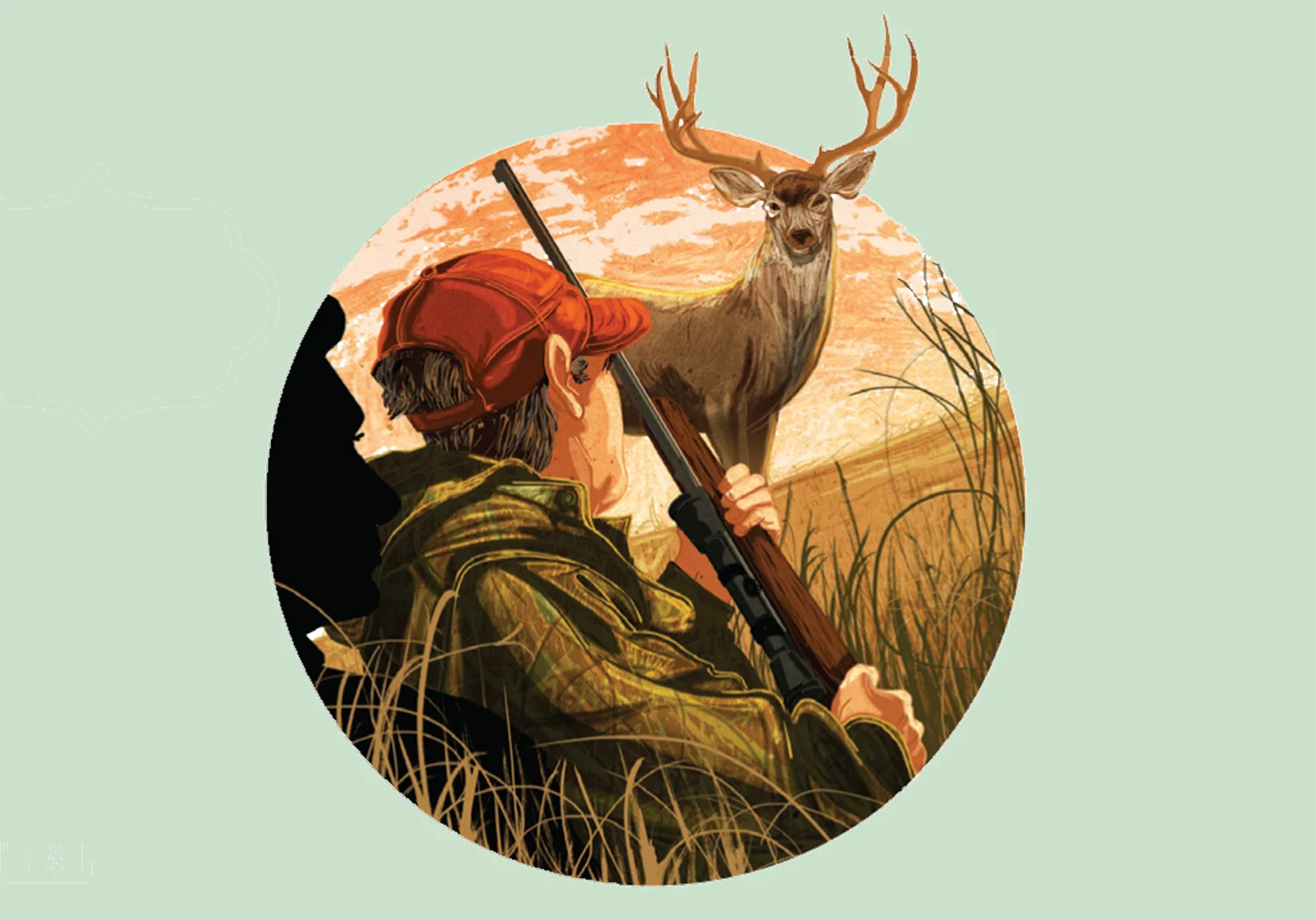
Jonathan Bartlett
Stalking is the most exciting part of hunting. Waiting is mostly tedium, and shooting, if you’re a good shot, is an anticlimax. But if a stalk doesn’t get your blood pumping, you should do something else for fun.
The best stalk I’ve ever been party to took place in Wyoming in the late 1980s. I was hunting mule deer with a rancher and guide named Don Mali, who was the best hunter of these animals that I’ve ever met. His art was based on an encyclopedic knowledge of the several ranches to which he had access, and an uncanny familiarity with every deer that dwelled upon them.
His technique was simple. Before sunrise, he would get in his pickup and drive to the top of a bluff. There he would sit with a very expensive spotting scope clamped to the window and watch the prairie as the sun rose.
While it warmed the sagebrush flats, deer heads would pop up, and eventually there would be antlers everywhere you looked. On this particular morning, he spotted two bucks perhaps a mile away. One was a satellite buck, a youngster, but the other was a veteran deer, a 6×4 with main beams that were only 15 inches wide but 21 inches high, and nearly 8 inches around their heavily gnarled bases.
“I’ll be damned,” said Don. “I’ve never seen him before. Let’s watch him.”
And so we did. The two bucks were feeding on the flat at the head of a coulee, unaware that anyone was around. Most hunters would have gone charging after them, but this was not the Mali way.
We waited a half hour, Don never taking his eye from the scope. Finally he said, “All right, now I know him; let’s go kill him.”
We could have driven closer and stalked, or gotten out of the pickup and stalked, but this was not the Mali way, either. Instead, we drove away from the deer, about 90 degrees, I would guess, for a couple of miles to where the coulee in which the big guy lived debouched into flat land.
“This coulee takes us right to where he is,” Don said. “Because we’re down below ground level he can’t get our scent. It’s about a mile, and when we get there, be ready to shoot, because we’re going to come out right on top of him.”
At least in theory we would. When you undertake an operation like this there are any number of ways it can go wrong. Moving quickly, it would take us 10 minutes to stalk up the coulee. In that time, the big buck could become bored and move to another spot. Or the satellite buck could move, taking the big guy with him. Or, what really worried me, there could be other deer in the coulee ahead, which when spooked by us would go bounding away, informing everything ahead that it was time to run. Or the big guy could simply decide, courtesy of that sixth sense big deer have, that something was wrong and it was time to clear out.
So we trotted along with our fingers crossed, and none of that stuff happened. Don stopped short (how he knew where to stop I have no idea) and pointed to the left. I closed the bolt as softly as I could and scrambled up the coulee bank and came face to face with the big deer. He was 20 yards away, if that. His expression was blank amazement, as though I had popped up out of the earth, which in a sense I had.
I shot him in the shoulder and he went down. I fired a second bullet into his heart to hurry things along. His head is on the wall above me as I write this.
One of the fascinations with the Titanic sinking is that if any of a dozen things had or hadn’t happened, or had happened differently, she might today be only a footnote in ocean-liner history. So it is when you begin to stalk an animal. If any of the many things that could have gone wrong did, the one I killed might have died of old age instead of a bullet.
And therein lies the reason why stalking will open up your adrenal glands. So much can go sideways, and so often it does. But when things do go according to the book and you’re taking out your knife to begin gutting, there is always going to be a part of your brain that says: “Well I’ll be damned. It worked.” —David E. Petzal
The Blooding
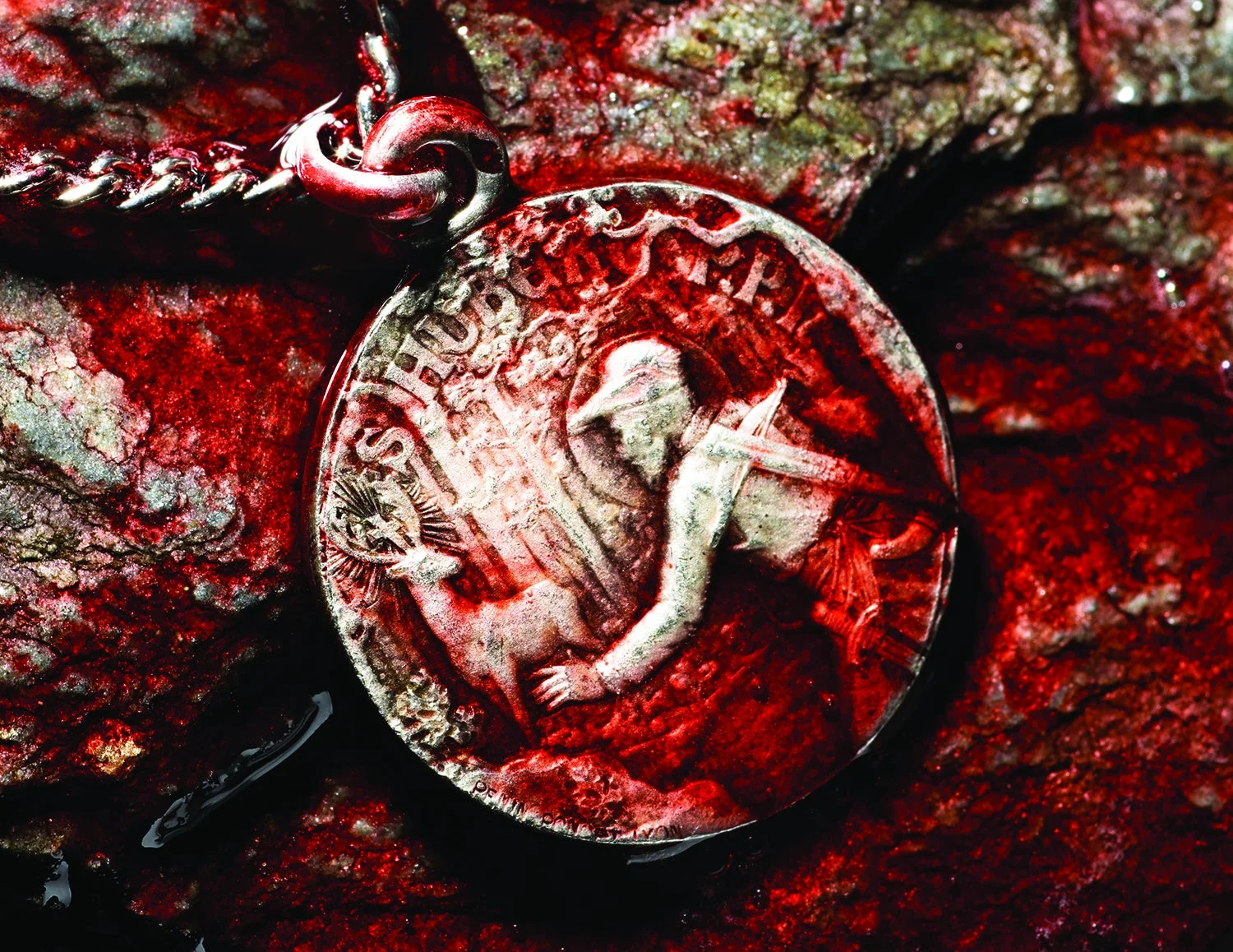
Levi Brown
They’re in shirtsleeves now, the trees nearby hung with camo packs and blaze orange hoodies. It’s hot work, dragging a deer, no matter the weather. Bill Stoner holds the buck’s hind leg, while his brother, Doug, unzips the belly.
The instant I stepped out of the cedar swamp, I could tell this was a moment for the ages. The 5-pointer is Doug’s first buck. His first deer. After eight years of trekking to his family camp on Drummond Island, off the northern Michigan shoreline, 8 dirt miles from the nearest hardtop road, Stoner has connected with a beauty. His brother’s presence is just icing on the cake: It’s the first time they’ve ever deer hunted together.
Working as a team, they roll out the entrails, cut the windpipe, and prop the chest open with a stick. As steam rises from the open maw of the cavity, Bill drags a thumb through the deer’s chest, painting his finger with the blood pooled between the ribs. Doug sits quietly. He knows what is to come.
This tradition—marking a hunter’s face with the blood of a freshly killed animal—is rooted in the story of St. Hubert, a first-century A.D. Frenchman who, before his religious conversion, chased deer pretty much 24/7. On one Good Friday, while the rest of his village was at church, Hubert was afield when the stag his hounds had cornered turned to face him, a crucifix illuminated between the antlers. The buck spoke with the voice of Christ, and Hubert’s life changed forever. He entered the priesthood, died in 727, and is the patron saint of hunters. For many years, a kill was marked with three crosses of blood on the forehead and cheeks of the hunter: one for the crucifix between the Christ-Buck’s rack, one for each of the antlers.
These particulars might be lost on the Stoner boys, but they know of this ancient rite, and if ever there was a time and place for it, this is it. Frank steps over the deer’s body and paints a single stripe of blood on his brother’s forehead. No video cameras. No empty platitudes. No fist pumps or Facebook postings. Doug nods slightly, looks down at the deer, and pats a shoulder—once, twice, thrice. A coincidence, perhaps.
Doug will return to camp with pockets bulging with the deer’s heart and liver, his forehead smeared with blood, the swipe marked with his brother’s own thumbprint. It will wash off, or wear off, in the days to come. At least, on the outside. —T. Edward Nickens
Chapter 3: Harvest
The Meal
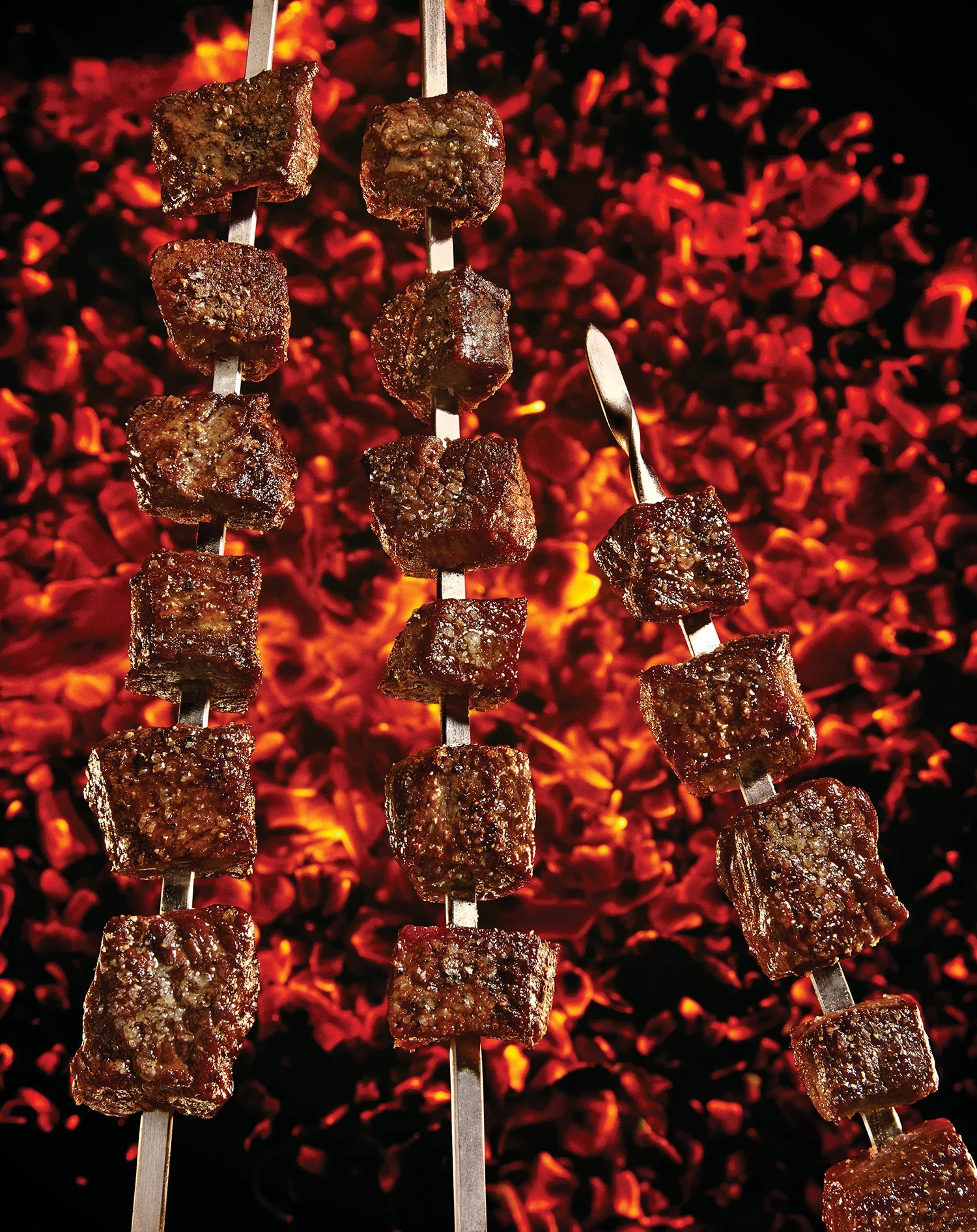
Jarren Vink; Julia Gartland (food styling)
The second breakfast is common tradition among ranchers and hunters, but in my family deer camp, the second supper is always the best meal of the day. Every night it’s the same thing—spiedies, the most pure and perfect hunter’s food.
Our camp is two Cabela’s Alaknak tents set up in an L shape around a tarp-wrapped popup awning that serves as the cook shack. By necessity and inclination, we eat supper outside around the fire, tossing our greasy paper plates into the flames. Nights here are long and can be cold, but no matter the weather, no one is anxious to turn in. By the time there is a deep bed of coals, we’ve told a few stories and had a few drinks, and everyone is ready for spiedies.
It’s a regional recipe from the Southern Tier of New York. The spiedie originated with Italian immigrants who put grilled, marinated lamb on a roll and served it as a workingman’s hot lunch, and in this hunting-crazy area the spiedie has evolved to often mean venison. Anyone who’s eaten Turkish kebabs or Japanese yakitori will recognize a spiedie as one of the world’s most universal foods: chunks of meat impaled on a stick and grilled over a flame.
You can find various spiedie recipes online, but the basic version is simple: Make a marinade that is equal parts red wine vinegar, olive oil, and beer. Mix in minced garlic, salt and pepper, lemon juice, and a spoonful of chili powder. Freshly chopped mint and parsley give spiedies their distinctive flavor, but you can use any herbs you want.
The main ingredient is one reason why everyone who goes to our camp hunts so hard during the early bow season: to make camp meat. A spiedie needs to be from the best cuts of venison—hindquarters cut into cubes and carefully trimmed. We fill a plastic bucket with a big batch of the marinade and venison, and when it’s time for second supper, we dig in and impale the glistening meat on skewers.
The rest is elemental. You rake a deep pile of coals against the fire ring and use stones to prop the skewers up over the heat. It’s critical that you pull them off when the outside is slightly charred, but the inside, still rare. A raw spiedie is better than one that’s overdone.
We don’t bother with rolls. We eat with our hands, right off the sticks, the venison burning our fingers, the inside cool and running with juice. We go around the circle, grilling enough until we’ve eaten our fill. Only then are we ready to shuffle off into the cold and into our bags, full, warm, and buzzing with the pleasure that men have felt for as long as there have been deer to hunt. —Anthony Licata
The Mount
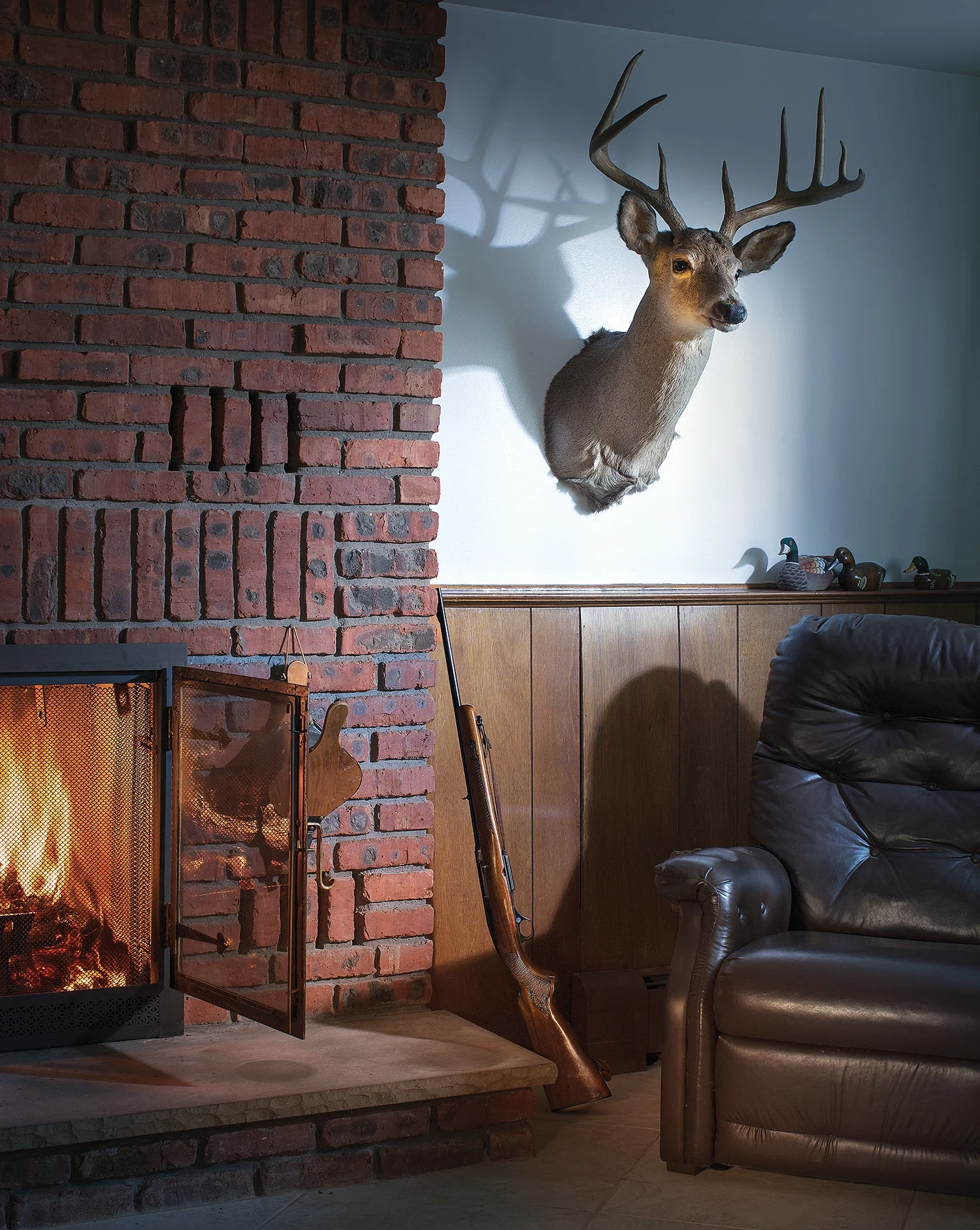
Henrik Knudsen
When I was younger, I never thought it would end this way. Not that I spent a lot of time pondering my father’s death when I was a teen, but for those few moments when I did, the image that came to mind was of our reminiscing about the good times: The white-antlered Pocono swamp buck that he’d shot and that I’d trailed and found a half mile away on my first ever real deer hunt. Those early Saturday morning fishing trips we’d taken in the little Starcraft cartopper, when every keeper largemouth and pickerel went on a chain stringer that I couldn’t resist pulling up and inspecting every 10 minutes. The giant, wild Fishing Creek brown trout with dime-size spots that he caught on an Abu Garcia Reflex spinner on a rainy opening day in the 1960s. And the one that I had on in the same stream in the 1970s for about three seconds, long enough to make my knees buckle in my waders as it disappeared forever into the deep, glassy green hole beneath the giant boulder that resembled a monument.
Instead, it ended with him unconscious in a hospital bed after I hadn’t seen him or spoken to him for 12 years.
Watching his chest rise and fall with each push of air from the respirator, I told him that I loved him and I was sorry that things hadn’t worked out. I told him all was forgiven and that I would take care of Mom. I put my old camo cap on his bed so he’d see it if he opened his eyes. I cried a bit. Then I drove to his house, walked into the downstairs room where his trophies were hanging, and looked, as I had thousands of times before, at the mount of the tremendous buck he’d shot five decades ago.
THE INSIDIOUS EFFECTS of alcoholism are well documented, but they’re often ignored by both the one suffering from the disease and those in the alcoholic’s life. For me, they were just a part of my father, because I’d never known him any other way. The abrupt mood swings—the friendly and fun-loving guy at the dinner table or the party or the deer camp who could suddenly turn hateful and vicious—well, that was Dad. The great opening-day trout excursions and weekend hunts for pheasants and rabbits were sandwiched by events such as his drunken screaming at my mother at midnight and finding him passed out at the kitchen table. If you don’t know your father any other way, it’s your normal.
As I got older I got into more fights with him. Part of it was the typical rebellion of a teenager being quelled by a parent, but there was another, darker element to it. Any difference between us, even if it was over something as insignificant as an opinion about a bass lure, could be rectified only by total surrender on my part. If I didn’t agree with him, I wasn’t just wrong, I was selfish. This, I realized later, was when the talons of the disease had started piercing deeper into his brain and begun the process of taking away the man I knew. But Mom wouldn’t leave him, I had no siblings, and I simply accepted the situation.
In my 20s, out of the house but remaining a dutiful come-over-on-the-weekends son, I began having solo “interventions” with him, although I didn’t know then that that was the term for confronting an alcoholic about his addiction. Yeah, I know I drink too much, he’d say every time, and afterward he’d drink less…when I was around. When you grow up in a household in which the predictability of a day was indicated by the amount of alcohol someone has consumed, you gain the ability, based on behavior, to decipher just how much. He never stopped. Several times I severed all ties with him, but eventually he’d reach out to me, and we’d go hunting and fishing together like we always did. But the bottle would always show up, and so would his angry demands of me to agree with all that he did and said, and his hostility toward everyone who didn’t.
Getting married and having two children proved a great distraction, at first. Whenever we’d get together, he’d put off the serious drinking until later. But that didn’t last, and I did a fine job of ignoring or deflecting the anger that he began directing toward my new family. But it had begun eating at my soul.
The terrorist attacks of Sept. 11 changed the way many Americans looked at the world and themselves, and I was no exception. In the days and weeks that followed, when all the terrible stories came out about the thousands of moms and dads who went to work that day but never came home, I thought about my wife and young children and what I was to them; what I needed to be. And I thought about the awful regrets I would’ve had if I’d been in one of those buildings instead of my own office less than 3 miles away, and had looked out the window to see death coming right for me.
I realized I’d been concentrating on walking the infinite tightrope that Dad’s drinking had stretched between him and me, keeping balance by rationalizing his behavior caused by the disease, and by accepting the anguish it caused. And I saw that I’d put my own family on that tightrope right behind me. If I fell off, they’d fall with me. In October, when I received yet another thunderous phone call from him about some perceived slight and with yet another irrational demand, I pleaded with him to stop. He didn’t, and I hung up on him for the last time.
THROUGH IT ALL, the mount was there. It was the first thing he carried inside the new house when my parents and I moved out of our apartment. Except for when the walls were being painted, it never moved from its spot on the right side of the fireplace. When I was a little kid I’d watch him carefully clean and polish the antlers before the holidays. He’d even use my mother’s hairspray on the hide. He had other mounts, but none with more mojo. I’d heard him tell the story about that buck so many times, often at my urging, that it became a memory of my own, something I play over in my head while sitting in the deer woods, waiting for shooting light.
A small-game hunter since he was a kid, my father had started out deer hunting as an adult without any good idea of how to go about it. He’d told me stories of walking through the woods not knowing what to do—jumping in front of boulders, marching around barren woods, looking for deer. But he joined a local hunting club, and he learned quickly. And he loved the sport, so much so that he and a friend booked a hunt in Nova Scotia—the deer hunting mecca for East Coast deer hunters back then. I was about 5 years old, and all I really remember is him wearing a solid red Woolrich coat in the little apartment, and then he was gone.
It’s impossibly huge, more moose than deer, stretching from the rafters way above his head all the way down to the ground.
When he got up there he found that his guide was a Native—a Mí’kmaq—and an expert woodsman, one of the few men I’d ever heard my father speak about respectfully. The Nova Scotia camp had a range of hunters, from those who had booked a hunt just to get away from home to those who came to get a once-in-a-lifetime chance at a trophy northern whitetail. My father was one of the latter. But as the week wore on, and more and more deer were getting hung in the shed as he spent day after day still-hunting fruitlessly with his guide, he felt frustrated. All that money, all that vacation time, and nothing to show for it.
But the guide was unconcerned. “We walk,” the guide would say every morning, and so they would.
On the next-to-last day, they were slowly working through an immense stretch of blowdowns, my father lifting one foot and then the other, over and over, tired and dispirited, knowing the hunt was nearing its end, but still hunting hard, staying quiet, scanning the woods. And then, suddenly, the buck. “One second he wasn’t there. The next second, there he was,” Dad had said. A high and wide 9-pointer that would dress out at 195 pounds, with a rack nearly perfect in symmetry except for the missing G4 on its right side, it was the biggest deer that Dad had ever seen in his life—even in pictures.
My father quickly raised his Winchester Model 100 semiauto, aimed through the open iron sights, and put a 180-grain Silvertip from the .308 into the deer’s shoulder. The buck went down, Dad ran up for the coup de grâce, and he got his first clear look at the buck of his lifetime.
FOR YEARS he kept a picture of the deer. I can’t find the photograph now, as I clean out his desk and closets and put his life away, but I close my eyes and it’s there. It’s a big vertical print stored in a cardboard folder of the type that school student portraits come in, taken when color photography had just gone mainstream. He looks a little bit like me when I was in my 20s. The whiskers on his face are thick and black from not shaving for a week. He’s wearing a checkered wool shirt and suspendered red britches, standing next to the freshly killed buck hanging in a shed. It’s impossibly huge, more moose than deer, stretching from the rafters way above his head all the way down to the ground. He’s smiling and his eyes are on fire with the exhilaration of a hunter who has just shot the biggest buck he’s ever seen, and, as it turns out, he’d ever see.
That’s the man I will remember—a young hunter who literally danced among the blowdowns deep in the Nova Scotia woods after killing that deer, so happy that he kissed the deer. And then kissed the guide on the cheek. And then kissed the deer again, laughing and not caring what the guide or anyone else would think about his doing such a thing. I open my eyes and again see that old, giant 9-point on the wall, and think about the joy it gave my old man, and me, and I smile. —Mike Toth
The Butchering
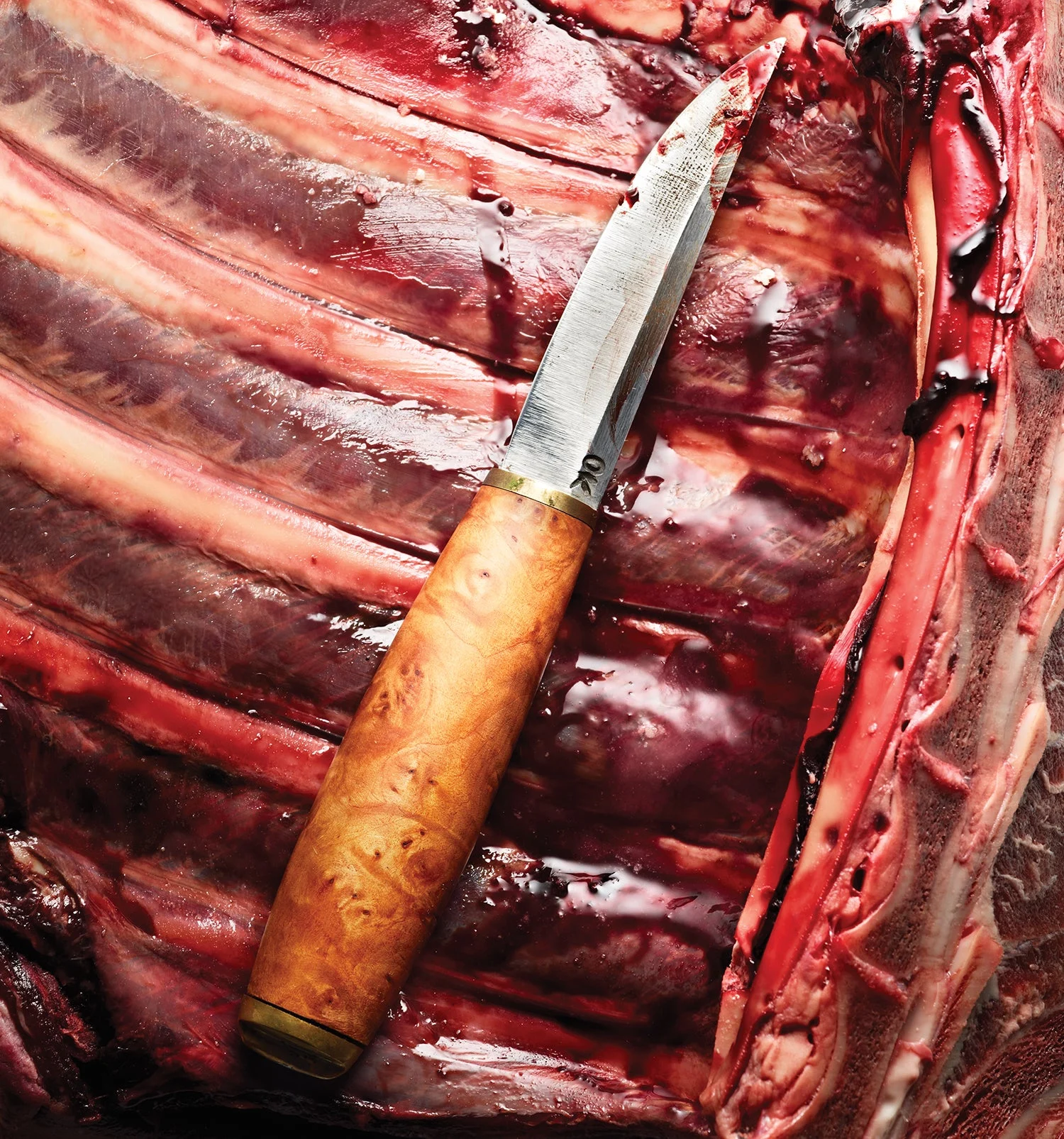
Levi Brown; Roscoe Betsill (food styling)
The hide is gone, the entrails are gone, the heart and liver saved for folks who like them—and now the shoulders, like wing bones, are cut away and laid on the picnic table beneath the oak, the powerful oak that has been fed over the years with the nutrients, the rinsed-away blood and tossings of ligature and scrap, from perhaps a thousand deer—
—and then the backstraps, the twinned and perfect symmetry running down the knobby keyboard of vertebrae, are removed, the knife working flat against that space, the red muscle pulling back to reveal white, the blade leaving no more meat in that space than the thinness of a sheet of paper—the paired ropes of the backstrap being laid out on the table, as the disassembly continues.
Next the hams, with the knifepoint finding the hidden ball joint and cutting it cleanly, and the feeling when it separates and you are left holding a hindquarter is yet another of about a hundred or even a thousand reminders that what you are doing is not artificial, that there is a responsibility in the day, the fact that you are continuing on deeper into life while the deer no longer is, though in at least two ways it is, the landscape that sculpted its red muscles and grace is still here, still going on, still shaping—sometimes gently, sometimes not—as are you, for a while longer—
—and the hams, the hindquarters, too, go on the table.
That’s enough to start with, there in the shade of that oak, with the sound of a football game coming faintly from the cabin, and your mind focused now on the craft of the task, cleaning the meat further, shaving off every wreath and filament of silvery fascia, de-electrifying those conduits that had housed and governed the once living, the knife and your hands unlearning or relearning the shape of every muscle large and small within those larger pieces—the meat in the cool autumn light looking almost iridescent sometimes, and so firm, like a beet, and with no fat.
The meat, the work of the day, will last all year if you use it right, for the best meals, the meals of ceremony and greatest gratitude.
You can’t help but think ahead to the black iron skillet, some olive oil mixed with butter, coarse black pepper, freshly ground, and kosher salt, some morels browning, and then the backstrap rolled in and cooked so quickly, seared on the outside and then taken out, the radiant heat of that brief time in the skillet continuing to cook the backstrap for a few minutes longer after it’s been put on the plate, the sear holding the juices in, maybe with some garlic-and-cream mashed sweet potatoes to absorb some of those juices, and then another, more delicate knife, cutting into the hot meat, and the juices coming out, and the steam—
Focus. The best thing maybe is that there’s no hurry. This is what you’ll be doing today, and the meat, the work of the day, will last all year if you use it right, for the best meals, the meals of ceremony and greatest gratitude. You want to do a good job. You want to do a job that in some way acknowledges the finality of the decision you made earlier in the hunt.
You wrap each piece tightly within the freezer paper—the tearing sound as you rip each sheet from the roller eliciting memories from deep within you across all the years, all the wild game cleaned and wrapped—and you tape up each serving tightly, to preserve them in the coming deep cold of the freezer, stacked like bricks of gold bullion.
The day passes. Your knife keeps working. The bones begin to gleam like marble. You return for more—neck roasts, neck loins, tenderloins, butt steaks, flank steaks; rib meat peeled laboriously from between the so-slender ribs for chili. The shanks, so dense, carved off for stewing. The deer vanishing, eventually, into the future. The deer vanishing, eventually, into you. —Rick Bass
The Drag Out
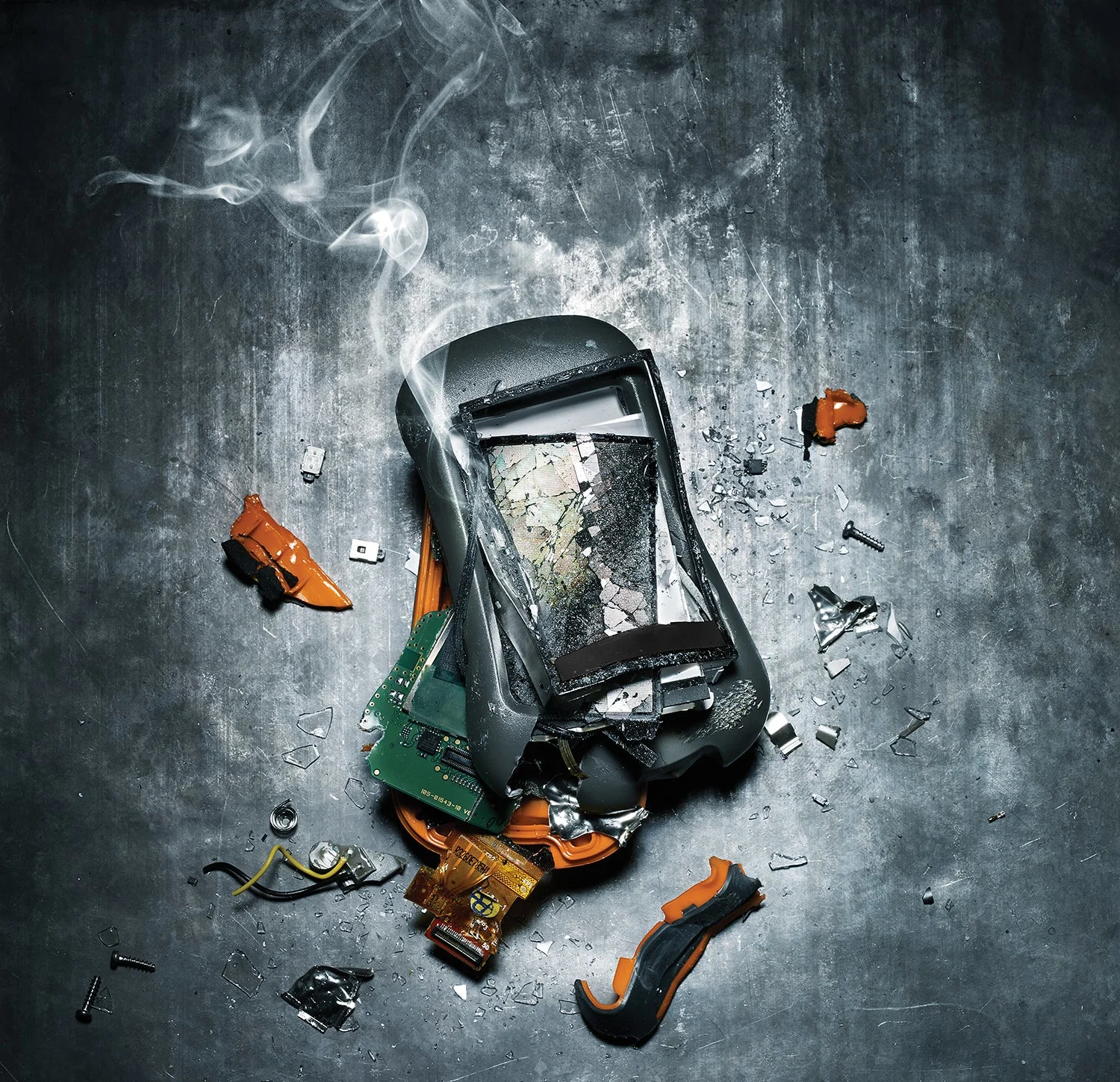
Yasu + Junko
I was bone-sore, sweat-drenched, and stuck. Behind me was an incline of jumbled boulders and blowdowns; ahead lay a latticework of massive, windfallen trees that choked off the ravine like a pile of giant pick-up sticks. I could see no easy way out.
My only consolation was the bulk of the problem. Tethered to my drag rope was a nice buck, which I’d shot several miles back into an Adirondack Mountain wilderness area. The 7-pointer, probably 190 pounds on the hoof, fell not far from a hiking trail. Normally I’d have dragged him out on what I knew was a good path. But my GPS showed I was also only about a half mile from the shore of a lake whose far end was a short canoe-carry from the road. That meant I could come back and paddle the buck out—after what I assumed would be an easy downhill drag.
So I gripped the rope and set off for the lake. It was fine at first. But after a while, with each step, I dropped deeper into a gaping ravine, increasingly studded with jagged rocks and strewn with huge trees, flattened like windblown straw by a long-ago storm.
Some logs lay partially suspended off the ground by the nubs of their broken branches. With these, I heaved the buck close to the trunk, tossed the handle of my drag rope underneath, clambered up and over, and finally yanked the carcass through the narrow gap. Others lay flat or, worse, crisscrossed. Here, I scrambled atop the trunks, hoisted the buck up, and then dumped it down the far side.
By the time I realized my mistake, there was no turning back. The steep sides of my personal hellhole boxed me in. So I had no choice but to plod on—under one windfall, over the next, again and again and again.
The skin on my hands was burned raw from the drag rope sliding through my grip. Blood trickled down my shin, which had been gouged by an antler point when, after hauling the buck atop another huge blowdown, I fell over backward, exhausted, and the rack came down on my legs.
Finally, after nearly four hours of this, I reached the lake, aching all over and ready to crush my GPS under a boot or launch it into the water. As for the buck, I’d pulled a third of the hair off its hide.
Years ago, the legendary Vermont tracker Larry Benoit told me that the hardest part of getting a big buck out of the big woods is shooting it in the first place. He was right, of course. But after the “Damned GPS Drag,” I will never, ever take a deer out on a blind bushwhack. I always take the known route now, even if it’s longer. —Lawrence Pyne
The Last Night at Camp
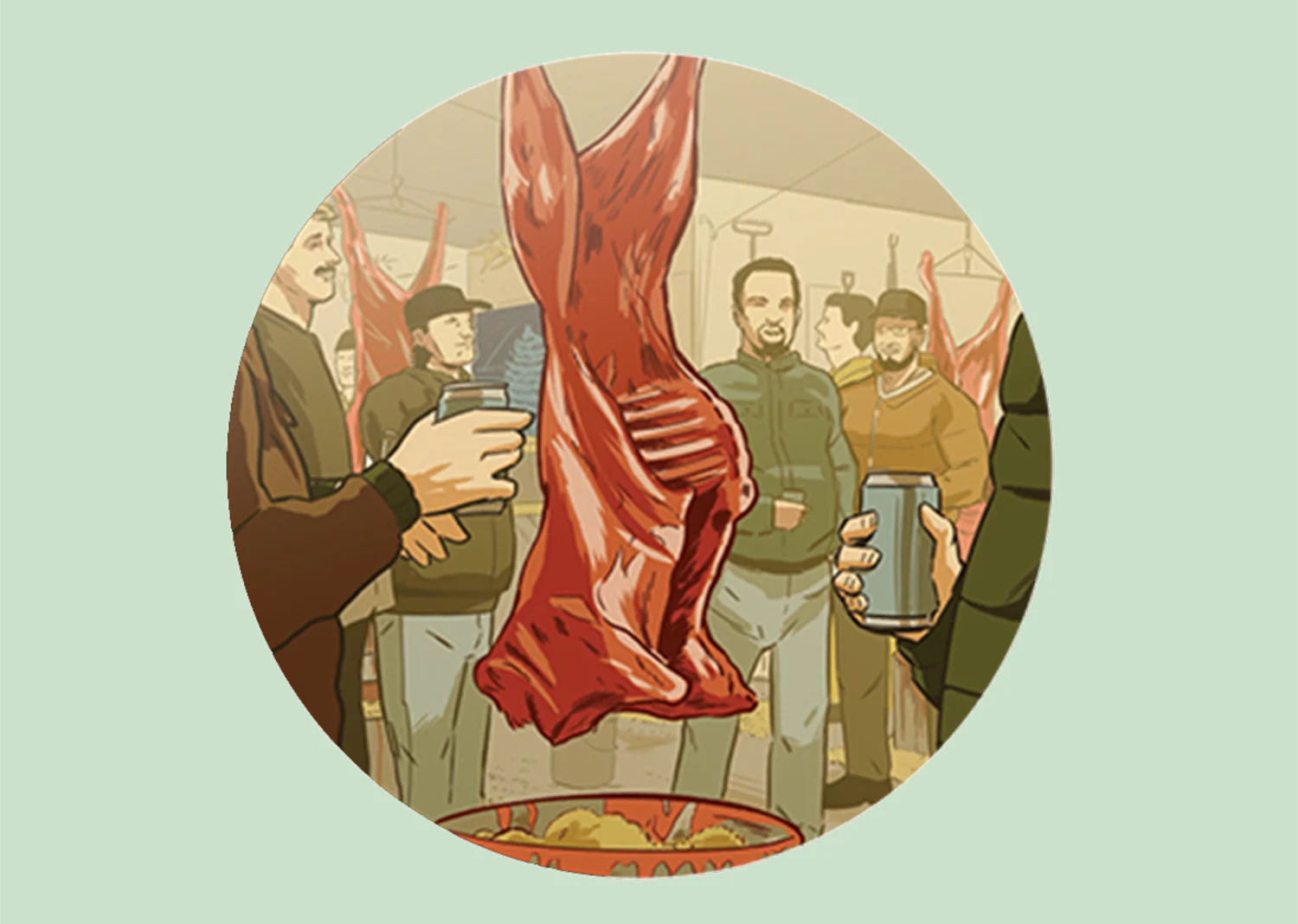
Guy Shield
There’s a curious power in a dead deer in that it has the ability to draw life. Hanging from a gambrel or a post, inside a barn or outside in the aging cold, a dead deer brings hunters away from the fire or out from the tent. It conjures a retelling of how it was hunted and the memories of other deer hunts. Guesses at its age, weight, and maybe score are offered. And when the chatter eventually dies, the animal is stared at in silence.
One dead deer is enough to bring a camp together, but last November, we had four bucks hanging and a fifth on its way. Spirits were high.
The garage was heated by a woodstove, and the room reeked of gasoline. Sawdust on the floor absorbed all the blood. Next door was the bunkhouse, which was warm and furnished with leather couches and a big screen with the NFL game playing. There was no question as to which place was more comfortable, but we still chose the garage. We wanted to hang out with the guides as they caped the bucks for mounts. We wanted to hear and share stories of the day’s hunts. We wanted to drink whiskey and laugh and rag on one another. Mostly, we wanted to be near the deer.
My favorite moment of the night came as two of the guides, Archie and Barry, were dressing the fifth buck. They removed the intact heart, sliced off a chunk, and rinsed it off. Then they half-jokingly offered it to Rebecca, who had killed that whitetail. She declined, but I volunteered. Those in the room who’d eaten raw deer heart (the guides) cheered and shook my hand. Those who hadn’t (everyone else) were revolted. Everyone laughed, and the night kept going.
I’ve gone back to that evening many times. Thing is, this wasn’t an old camp of longtime friends. This took place at a modest lodge filled with guests who’d been acquainted for only a few days. But that night in that garage, with our deer in the heart of the room, we were a camp of hunters who’d been friends for life. —Colin Kearns
_This collection first appeared in the February 2014 issue. Read more F&S+
stories._

